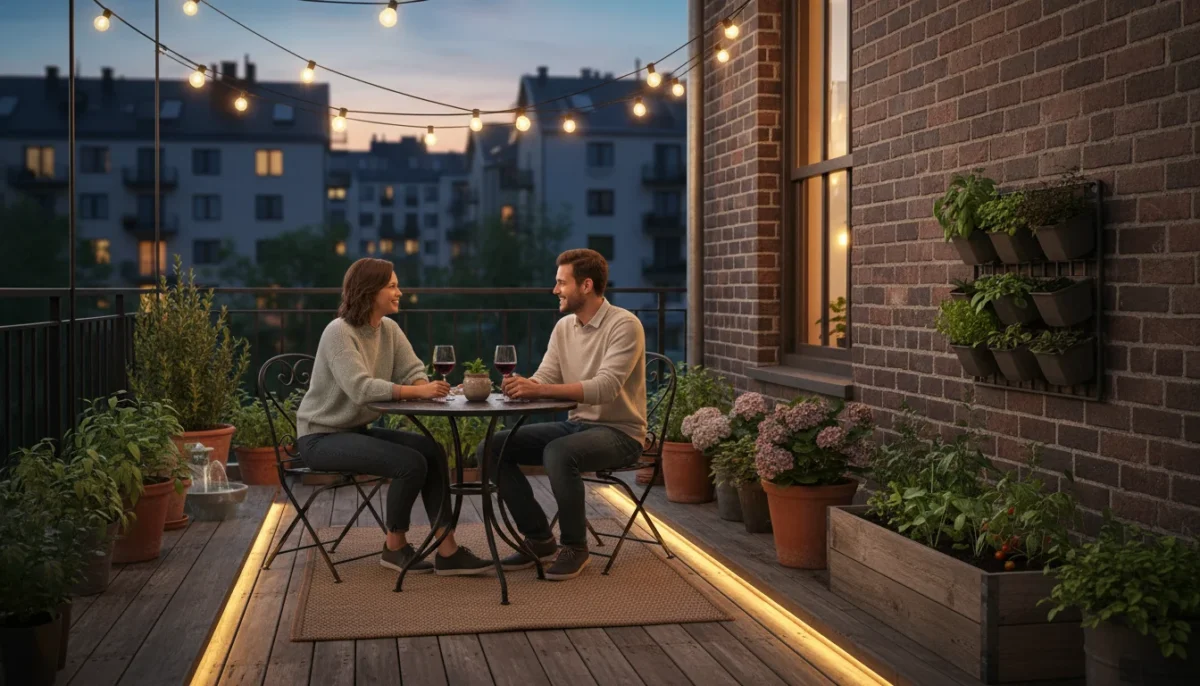You can transform your balcony, patio, courtyard, or compact yard into a magical evening retreat with thoughtful garden lighting. Effective lighting extends the use of your outdoor area well past sunset, adds a layer of safety, and highlights the beauty of your plants and design elements. This guide offers practical, actionable insights for creating stunning and functional lightscapes in your small garden, all while keeping maintenance low and your environmental impact minimal. We focus on enhancing your outdoor living experience, ensuring your small space looks inviting and stays easy to manage.
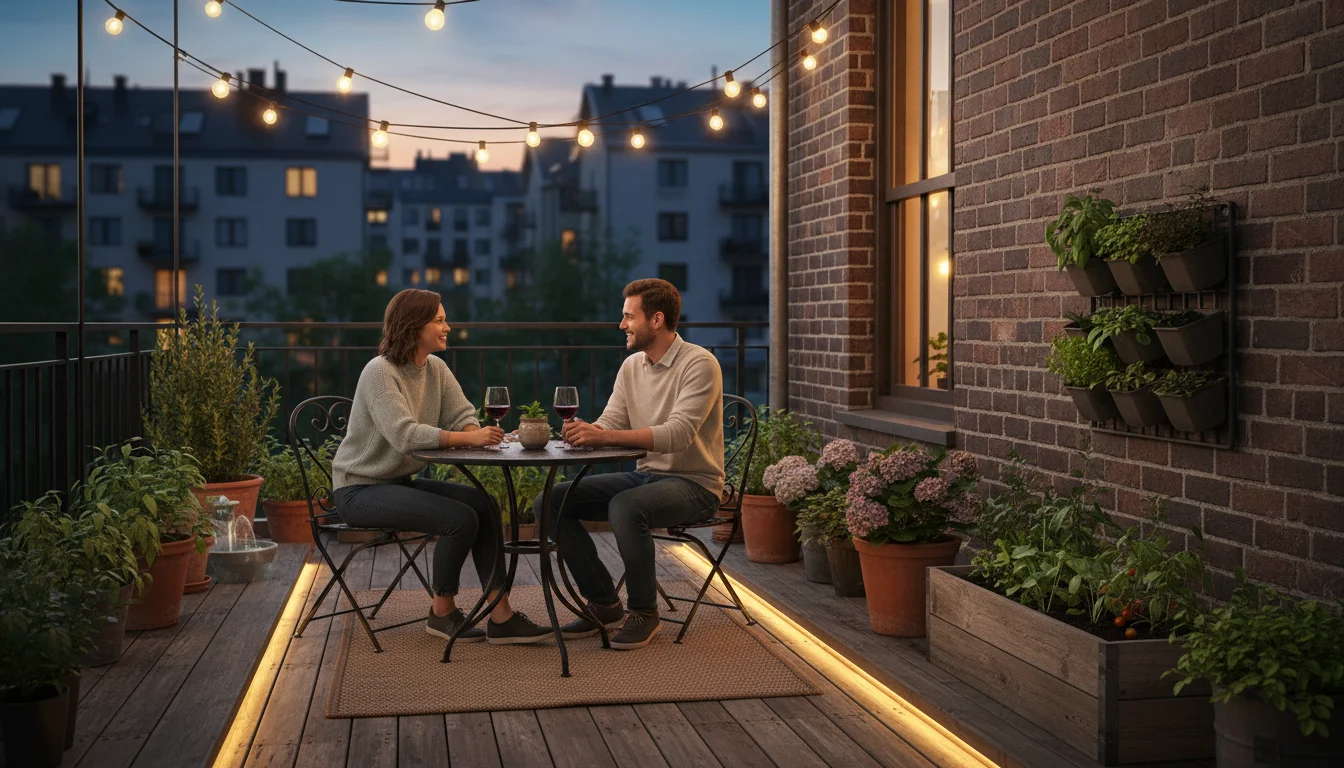
Why Light Your Small Garden? More Than Just Illumination
Lighting does more than simply allow you to see in the dark. For your small garden, whether it is a cozy balcony, a bustling patio, or a quiet courtyard, strategic lighting creates an entirely new dimension. You gain extended usability, meaning those warm summer evenings on your patio garden design do not end when the sun goes down. A well-lit space invites you to linger, dine, or simply relax outdoors longer.
Beyond extending your enjoyment, garden lighting significantly boosts safety. Illuminated pathways and stairs prevent trips and falls, a crucial consideration for any outdoor area, especially compact ones where obstacles might be close to walking paths. You can clearly define boundaries and steps, making your small garden more secure for everyone who uses it.
Aesthetically, light serves as a powerful design tool. You can highlight specific plants, sculptures, or architectural features, turning them into captivating focal points. A focal point is simply the first thing your eye notices. Uplighting a striking potted fern, for example, casts dramatic shadows and draws attention to its unique form. Soft, ambient lighting creates a welcoming atmosphere, transforming a simple balcony into an intimate escape. Data shows that outdoor lighting can increase home enjoyment and perceived value by enhancing curb appeal and functionality after dark. For instance, a well-planned balcony lighting scheme makes your outdoor space feel like a natural extension of your indoor living area, adding square footage to your usable home.
Thoughtful lighting enhances the visual appeal of your space, making it feel larger and more intentional. By strategically placing lights, you can guide the eye, create depth, and define distinct zones within your compact outdoor area. This attention to detail elevates a basic outdoor area into a truly designed space, offering both beauty and function.
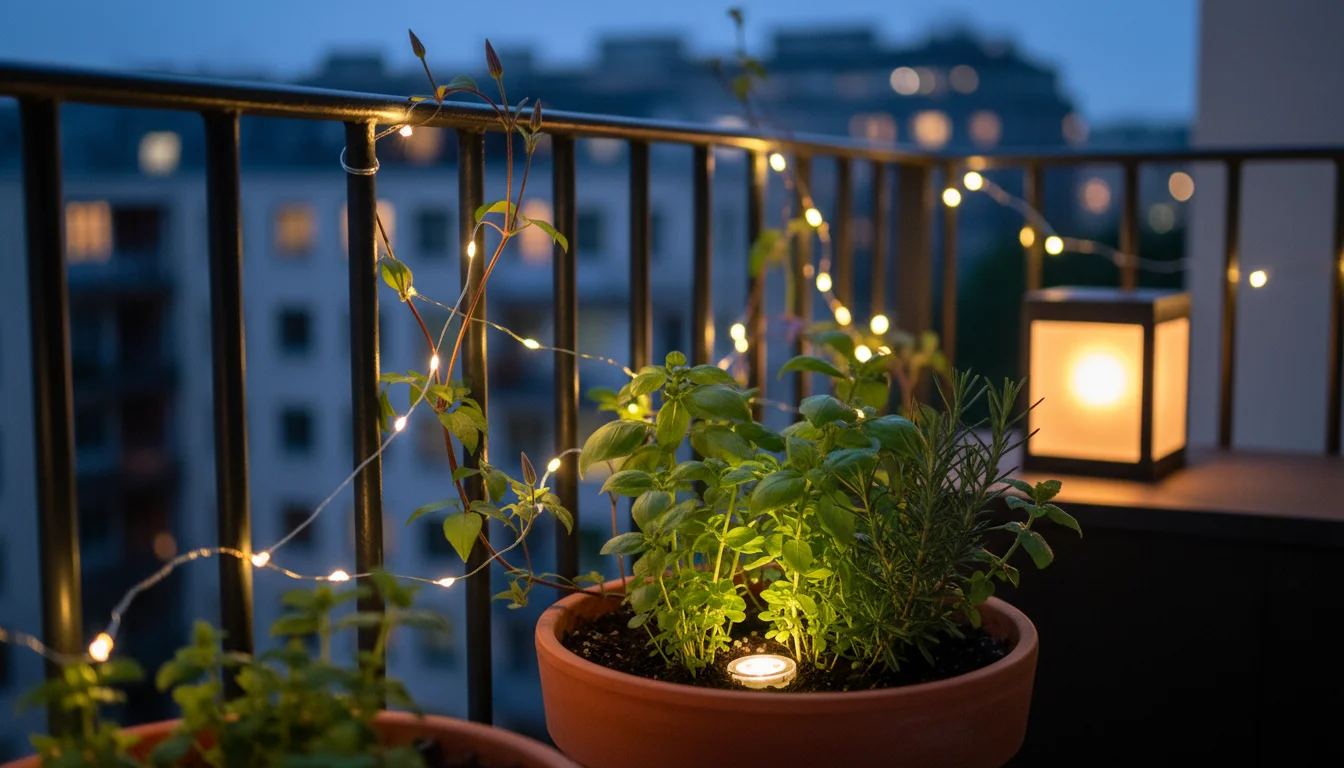
Understanding Light Types for Compact Spaces
Selecting the right type of lighting forms the foundation of any successful garden lighting plan. Each option offers unique benefits and challenges, especially when working with limited square footage. Understanding these differences allows you to make informed choices that fit your needs, budget, and desired aesthetic for your balcony or patio garden design.
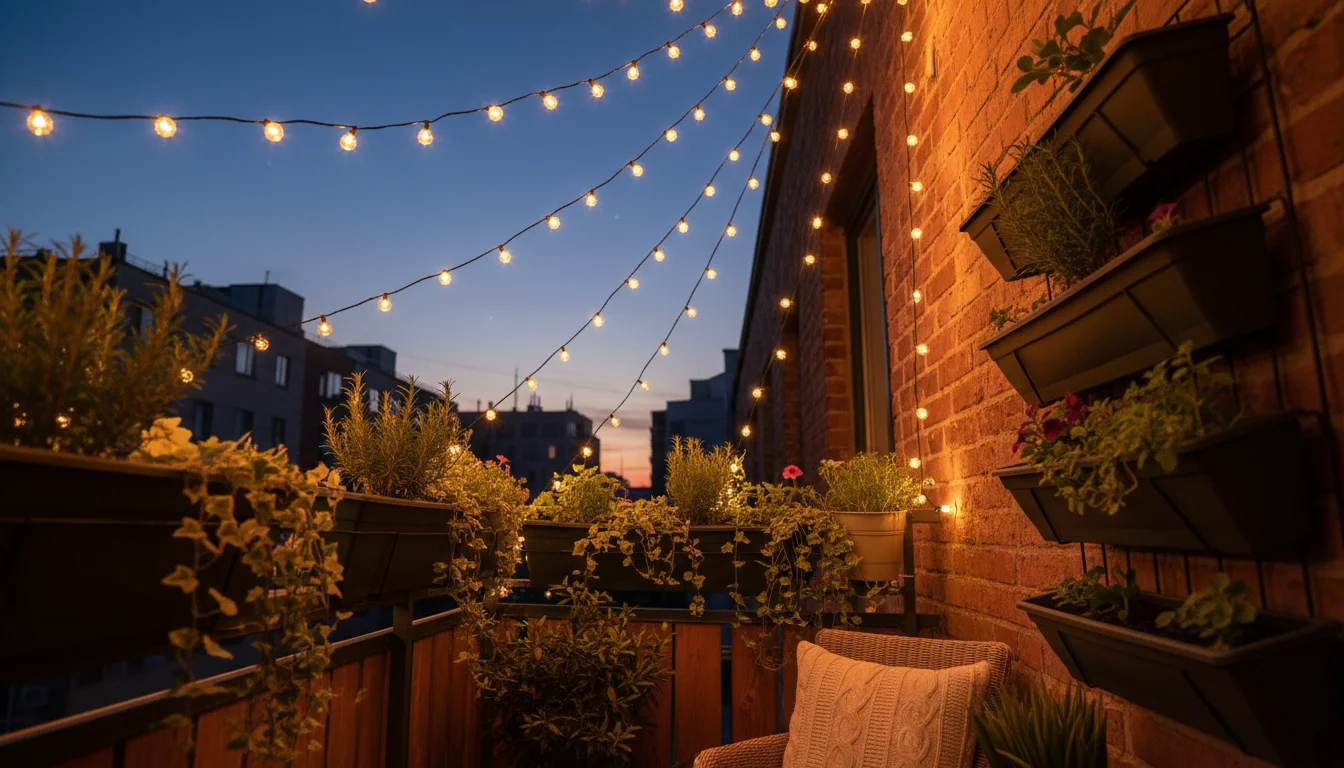
String Lights
String lights, often called bistro lights or fairy lights, offer a charming and versatile solution for small spaces. They provide a soft, ambient glow that instantly creates a festive or cozy atmosphere. You can drape them along railings, weave them through trellises, or crisscross them overhead to create a canopy effect. Many string light sets now use energy-efficient LED bulbs, significantly reducing power consumption. Solar-powered options are also widely available, eliminating the need for outdoor outlets and making installation simple. For example, a 15-foot strand of LED bistro lights uses about 15 watts, which is considerably less than incandescent alternatives. Their adaptability makes them a popular choice for quick and impactful balcony lighting transformations.
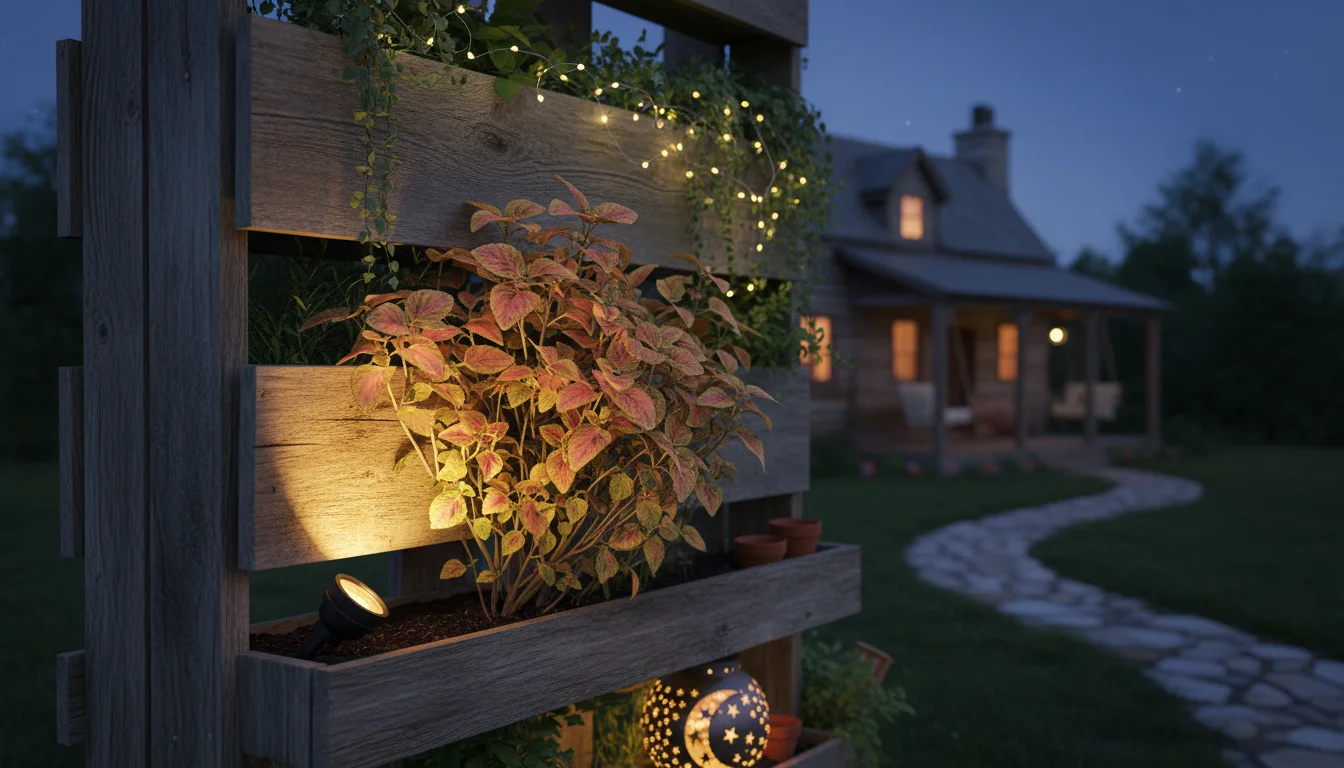
Solar Lights
Solar lights offer an incredibly convenient and eco-friendly option. They charge during the day using small solar panels and automatically illuminate at dusk. You find them in various forms, including pathway stakes, decorative lanterns, spotlights, and even integrated into some string lights. Their primary advantage lies in their easy, wire-free installation. You simply stake them into the ground or hang them where sunlight hits. However, their brightness and duration of illumination depend heavily on the amount of direct sunlight they receive during the day. For areas with limited sun exposure, you may experience reduced performance. Quality varies widely, with higher-grade solar panels and larger batteries providing more reliable and longer-lasting light.
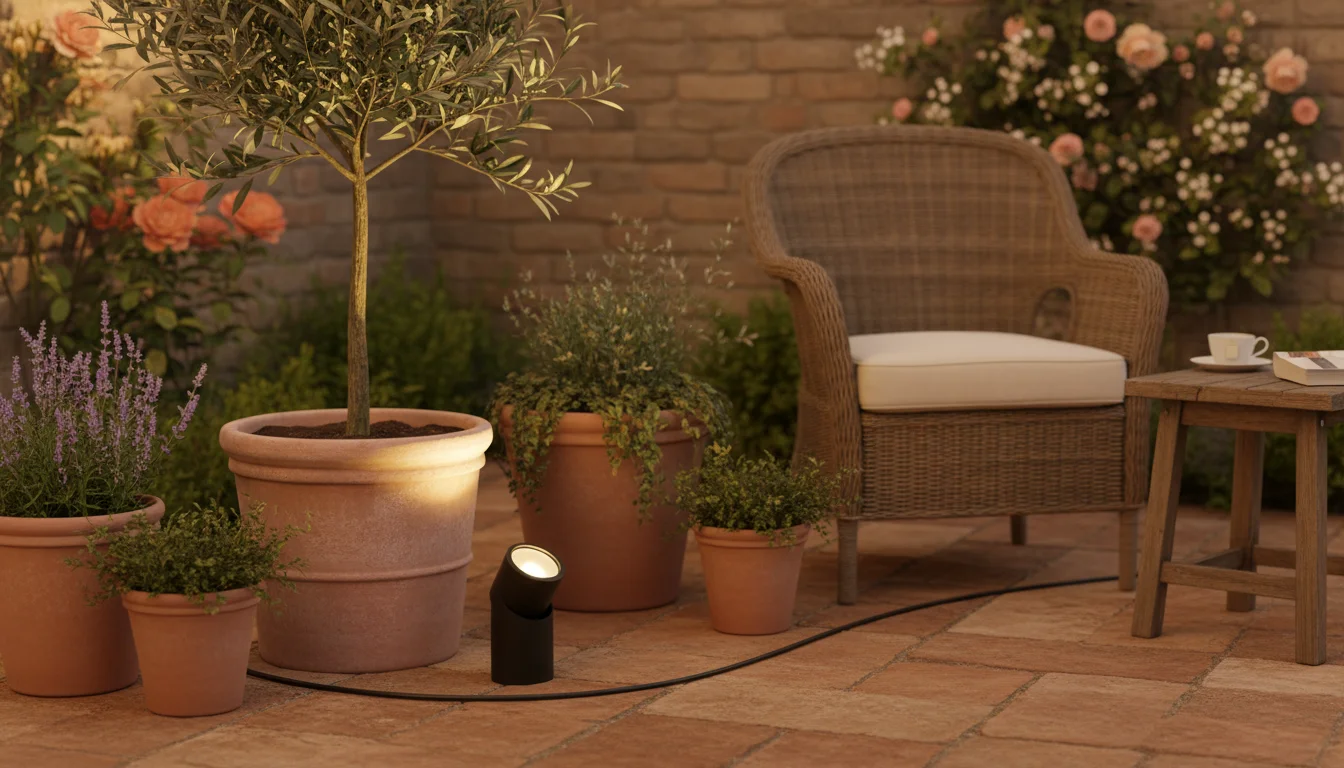
Low-Voltage Wired Lighting
For a more permanent and robust garden lighting solution, low-voltage wired systems provide consistent brightness and greater control. These systems involve a transformer that plugs into a standard outdoor outlet, reducing household current to a safe 12 volts. You then run low-voltage cables to various fixtures like spotlights, path lights, or floodlights. While installation requires more planning and effort, often involving burying wires and connecting fixtures, the results offer professional-grade illumination. You gain precise control over light direction and intensity, making them ideal for highlighting specific plants or architectural details with powerful, focused beams. They are particularly effective for patio garden design where you want reliable, long-term illumination without battery dependency.
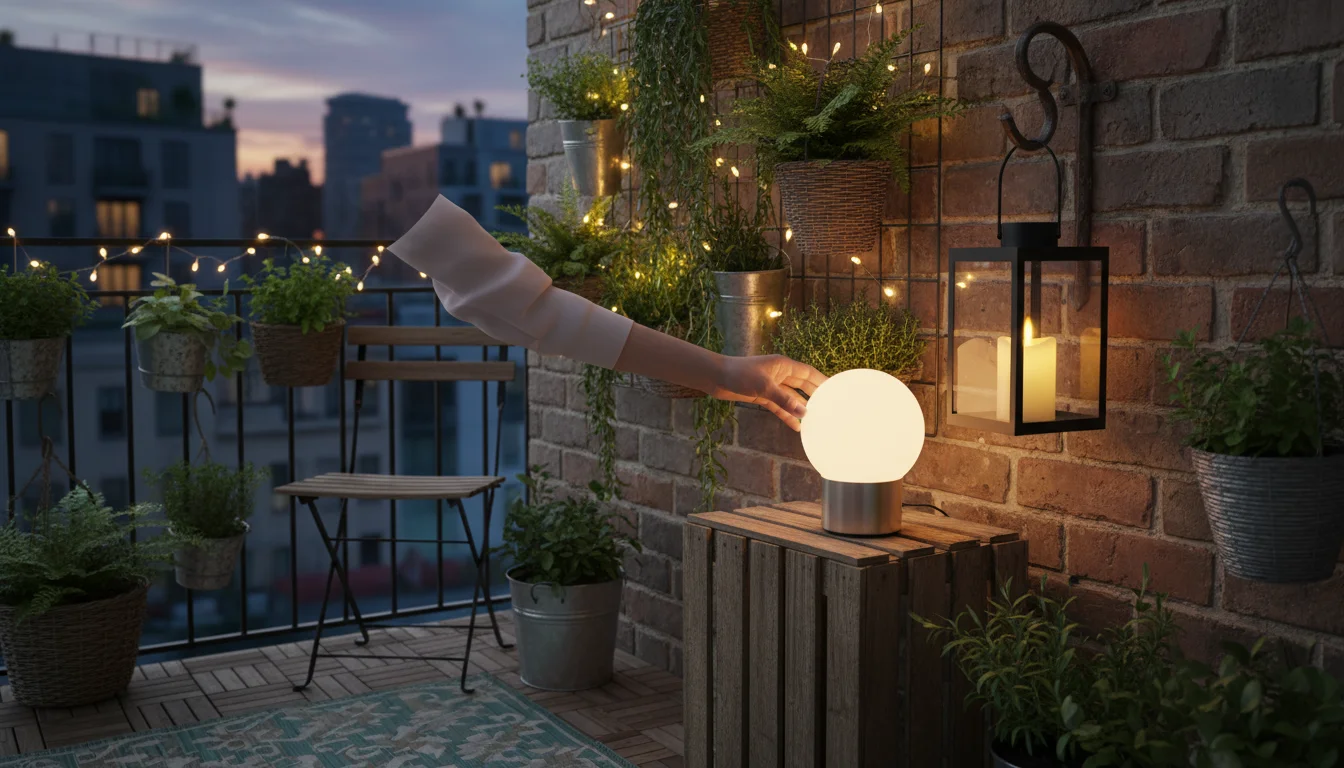
Portable and Battery-Operated Lights
Battery-operated lanterns, table lamps, and decorative luminaries offer ultimate flexibility. You can move these lights around as needed, setting them on tables, hanging them from hooks, or placing them on ledges. Many modern options are rechargeable via USB, making them even more convenient and reducing battery waste. They are perfect for adding temporary pops of light or creating dynamic arrangements for gatherings. Their portability means you can adjust your balcony lighting scheme on a whim, responding to different needs or moods without any fixed installation.
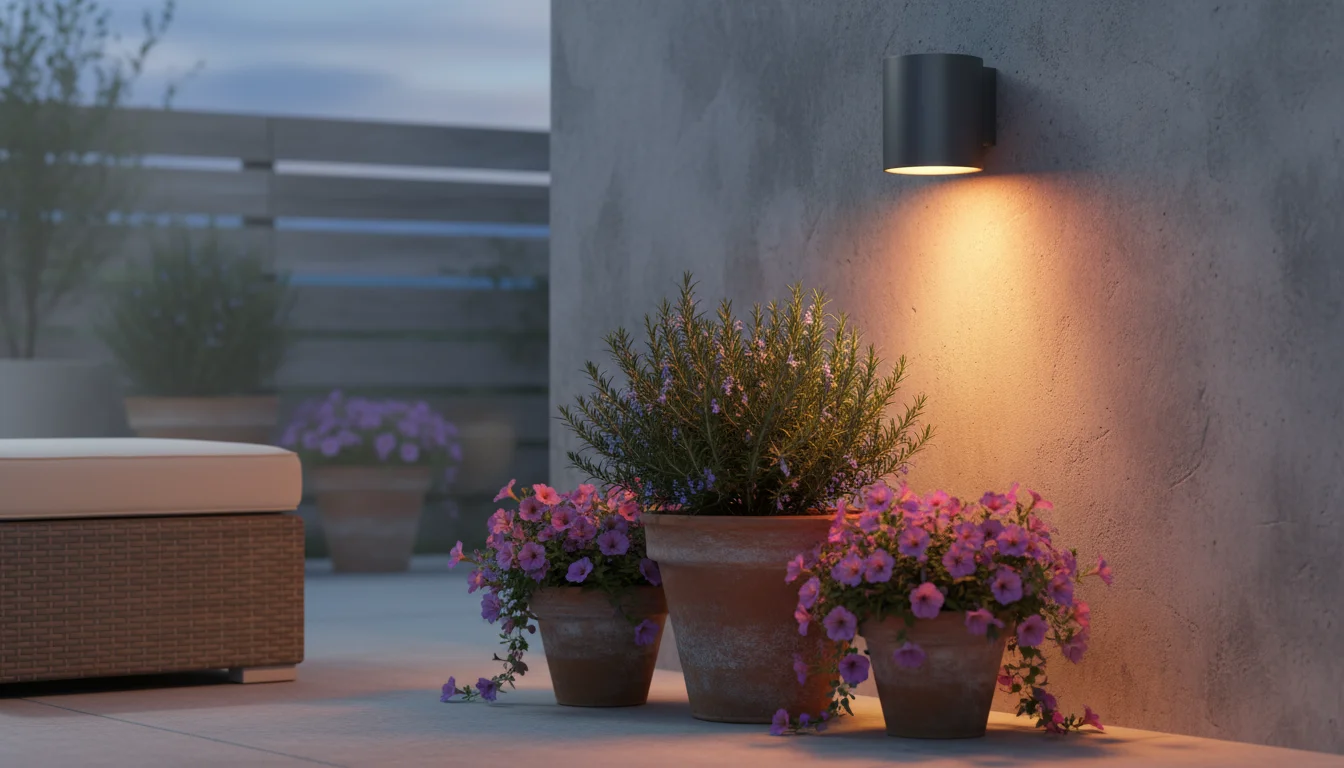
Wall-Mounted Fixtures
Sconces and other wall-mounted lights offer a functional and aesthetic addition, particularly for patios or courtyards with accessible walls. These fixtures provide general ambient light and can wash a wall with a soft glow or direct light downwards for pathway illumination. You typically install these with a professional electrician as they often require hardwiring. They contribute to a more finished, architectural look and work well for entrance areas or defining seating zones.
To help you choose, consider this comparison of common small-space lighting options:
| Light Type | Pros for Small Spaces | Cons for Small Spaces | Ideal Use |
|---|---|---|---|
| String Lights (LED) | Easy installation, warm ambiance, flexible arrangement, energy efficient. | Can look cluttered if not managed, potentially fragile bulbs. | Ambient overhead lighting, railing decor, defining a cozy zone. |
| Solar Path/Spotlights | No wiring, zero energy cost, easy to move, sustainable. | Brightness varies with sun exposure, shorter duration, lower intensity. | Highlighting individual plants, subtle path markers, accenting small features. |
| Low-Voltage Wired | Consistent brightness, precise control, durable, professional look. | Higher initial cost, more complex installation, requires an outlet. | Strong focal point illumination, reliable pathway lighting, architectural accents. |
| Portable/Battery-Op | Ultimate flexibility, no wiring, can move freely, instant setup. | Requires battery replacement/charging, brightness may be limited. | Table lighting, temporary decor, mood lighting for specific events. |
| Wall-Mounted | Permanent, provides general or task lighting, clean aesthetic. | Requires electrical installation, less flexible placement. | Entryway lighting, illuminating seating areas, architectural emphasis. |
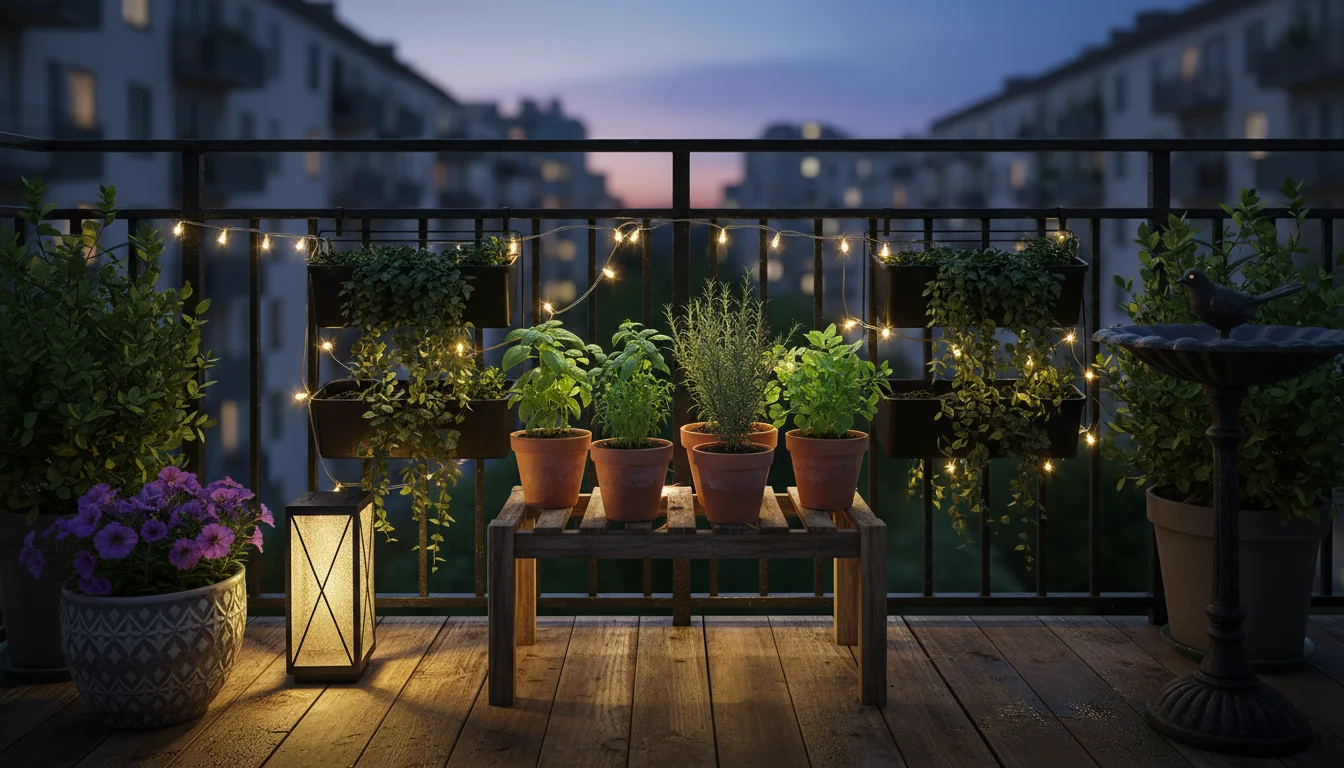
Designing with Light: Creating Ambiance and Focal Points
Effective lighting design involves more than just placing lights; it means using light to craft an experience. You can transform a flat, dark space into an engaging, multi-layered environment by consciously thinking about ambiance and focal points. This approach applies whether you are planning balcony lighting or a full patio garden design.
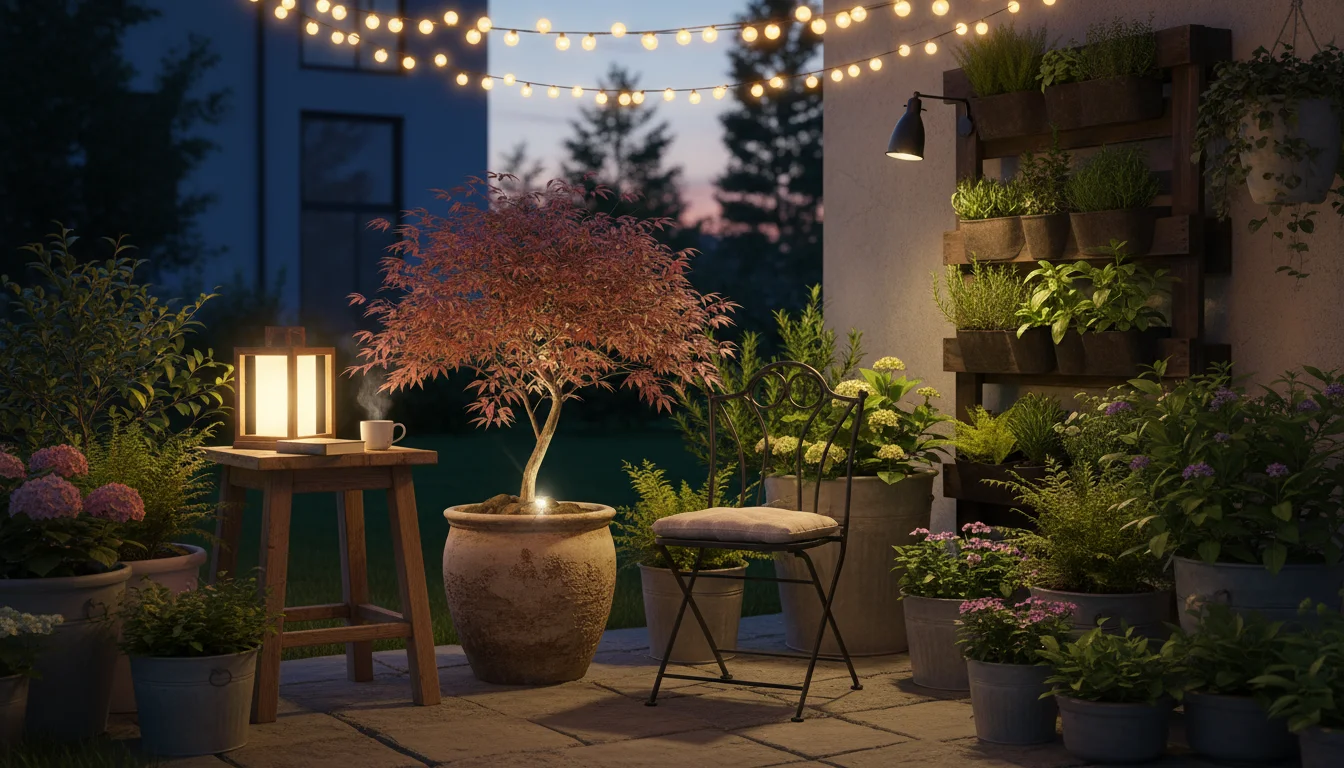
Layering Light
Think about your outdoor space in terms of layers of light, just as you would layer plants in your garden. This creates depth and interest. You typically use three main layers:
- Ambient Lighting: This provides general illumination, allowing you to see and move around safely. String lights, softly glowing lanterns, or indirect wall washes are excellent choices for ambient light in small spaces. They create a base level of comfort and visibility.
- Accent Lighting: This layer highlights specific features, drawing the eye to what you want to showcase. Use small spotlights or uplights to illuminate a prized container plant, a piece of garden art, or an interesting texture on a wall. This is where your focal points truly shine.
- Task Lighting: If you plan to read, cook, or engage in specific activities outdoors, you need task lighting. A directed light over a small outdoor dining table or near a grilling station serves this purpose. While less common in very small balconies, it is vital for functional patios.
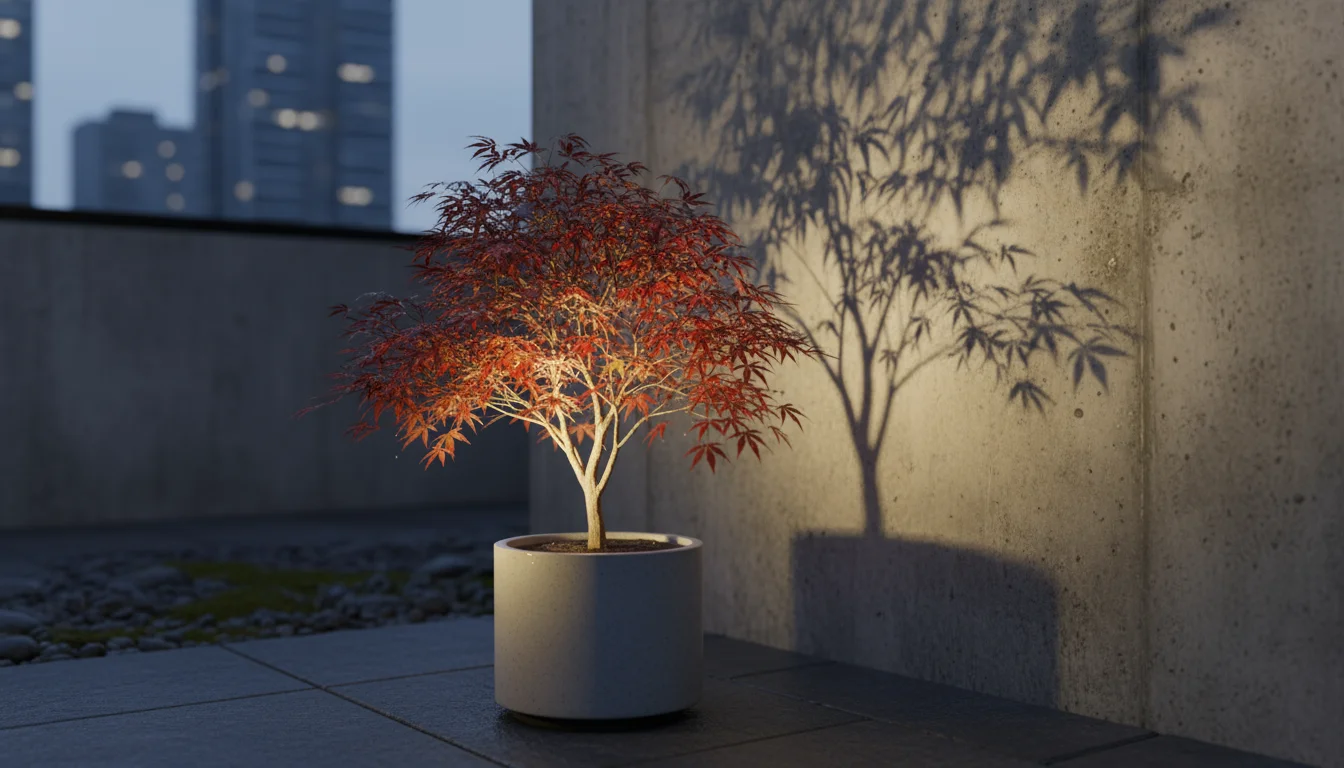
Creating Focal Points with Light
A focal point is the standout element in your design, the first thing your eye settles on. In your small garden, you can use light to create or enhance these focal points. For example, if you have a particularly beautiful specimen plant, like a dwarf Japanese maple in a striking pot, direct a narrow-beam spotlight at its base. The light will illuminate the plant from below, creating dramatic shadows and emphasizing its form against the darkness. This technique adds depth and sophistication to your patio garden design. For your balcony lighting, a string of fairy lights artfully woven through a hanging basket can turn an ordinary plant into an evening showstopper.
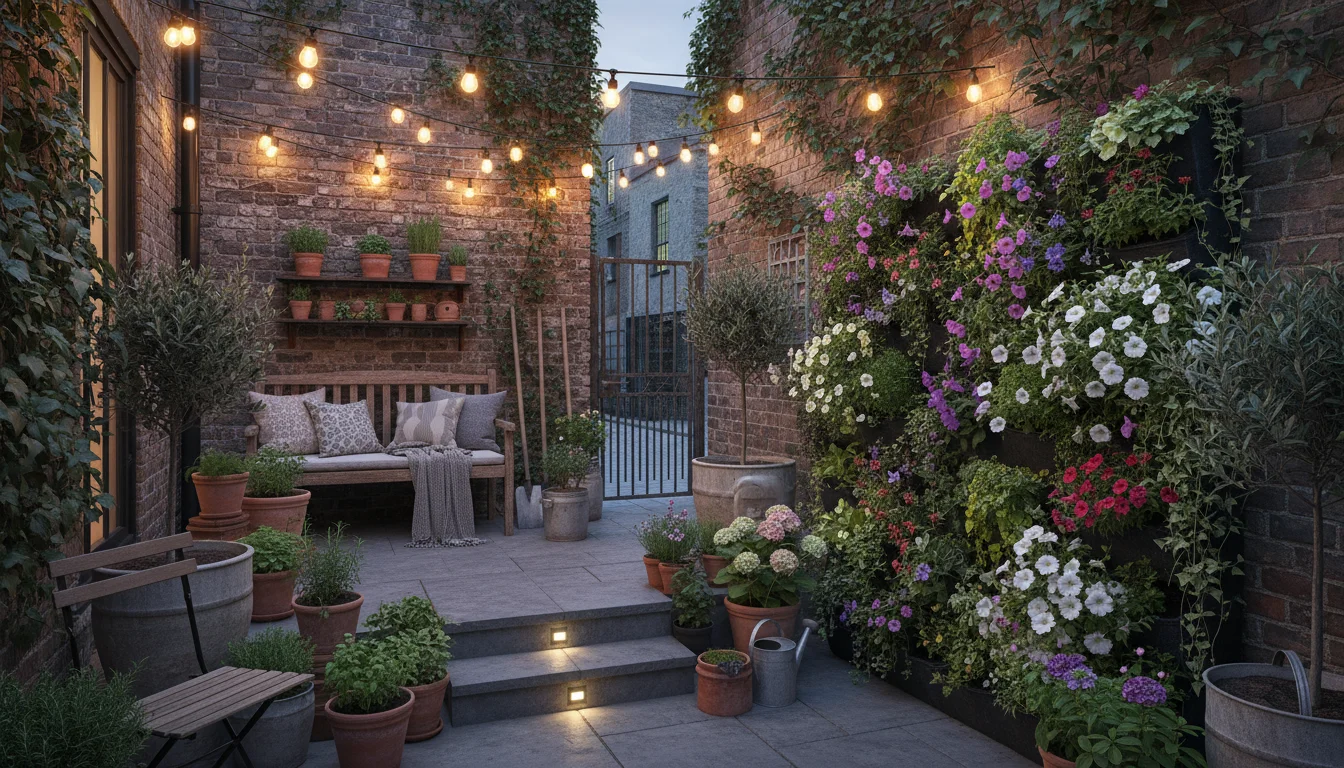
Defining Zones and Guiding the Eye
In a compact outdoor area, light can help define different zones, even if they are only perceived. A cluster of string lights over a seating area immediately designates it as a cozy relaxation zone. A series of small path lights can subtly guide visitors along a compact walkway, even if it is just a few steps long. The way you position your lights influences how you and your guests experience the space. You can use light to draw attention to the most beautiful parts of your small garden and gently steer the eye away from less attractive elements, such as utility boxes or storage areas.
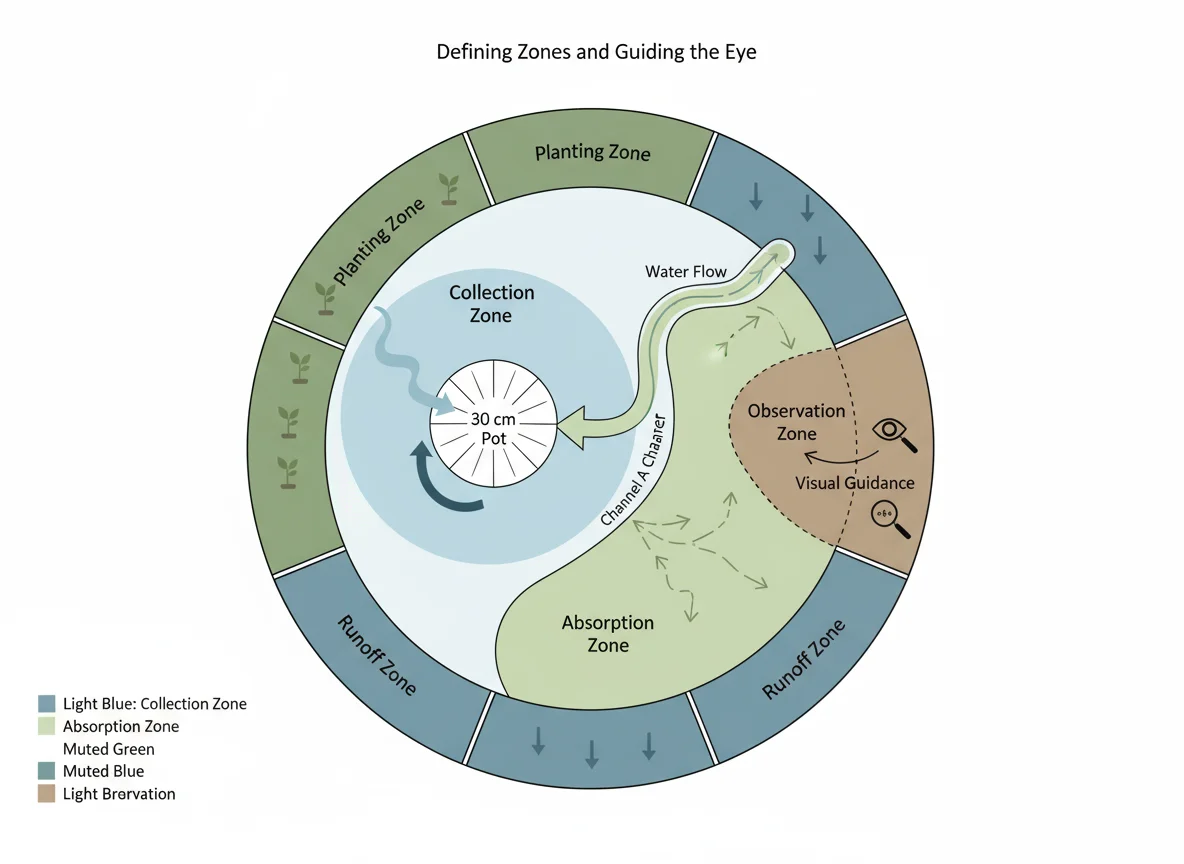
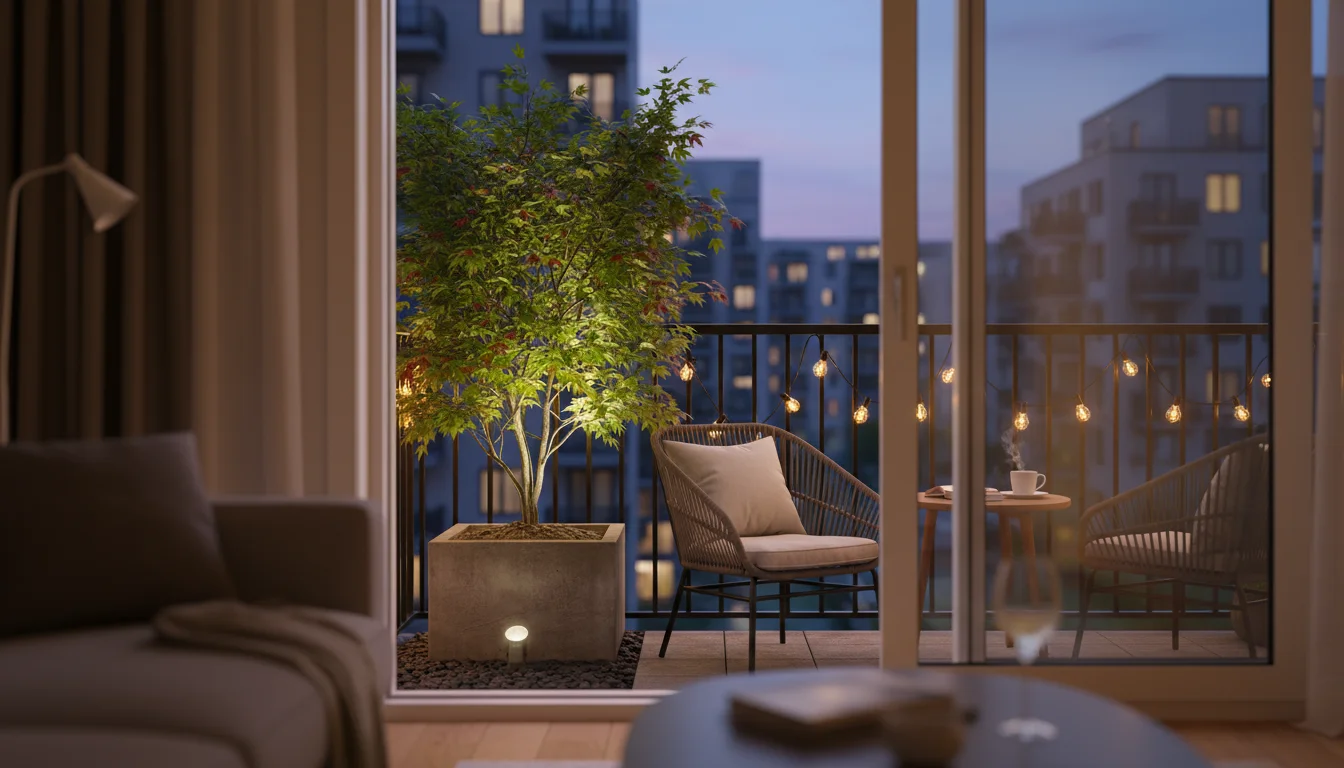
Considering Sightlines from Indoors
Remember that your small garden is often viewed from inside your home. Think about what you see when you look out your window or open your door. This is a crucial sightline. Position lights to enhance this view. For instance, you might strategically place an uplight on a plant that is visible from your living room window. This transforms your outdoor space into a living piece of art that you can enjoy even when you are indoors. Good balcony lighting design considers both the external and internal viewing experience, adding year-round appeal.
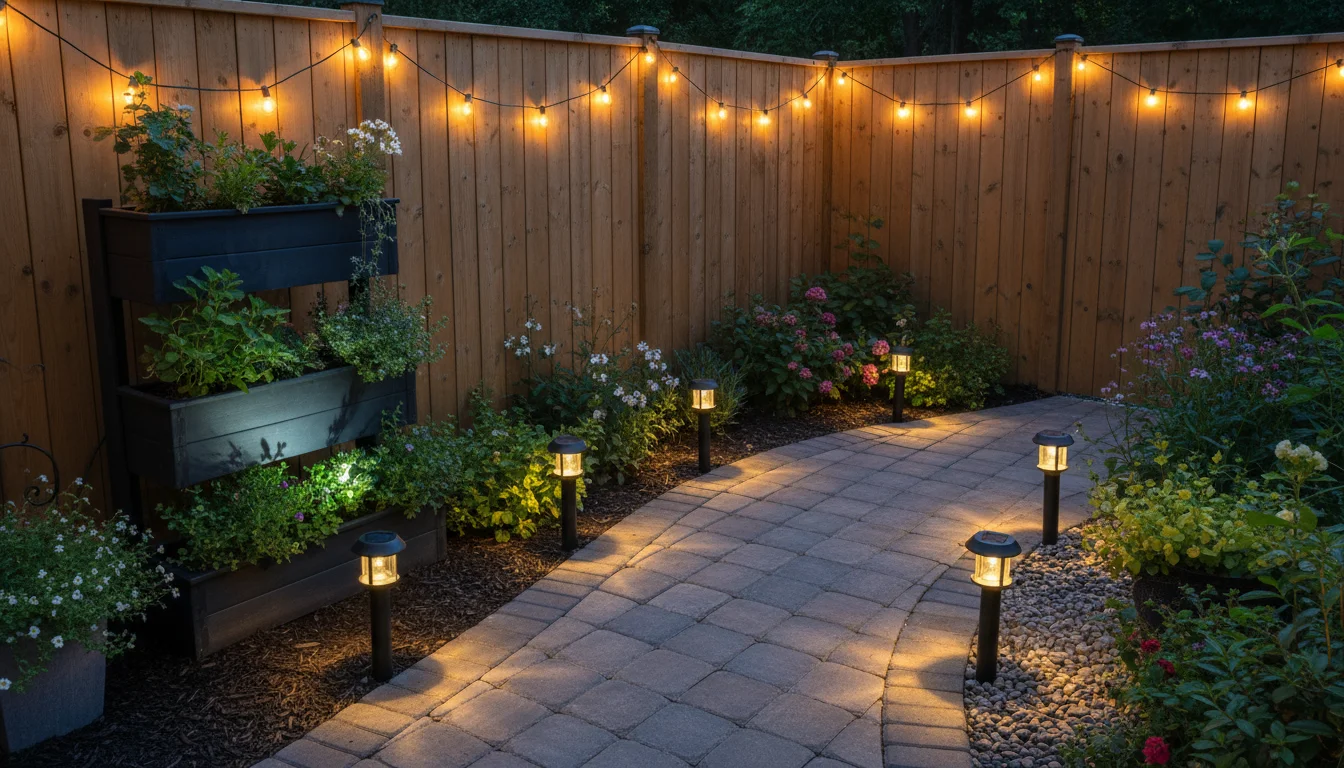
Practical Placement: Safety and Functionality
Once you understand the types of lights and design principles, you must focus on practical placement. This ensures your garden lighting is both effective and safe, especially crucial in compact outdoor living areas. Consider the functionality of each light and its impact on comfort and safety.
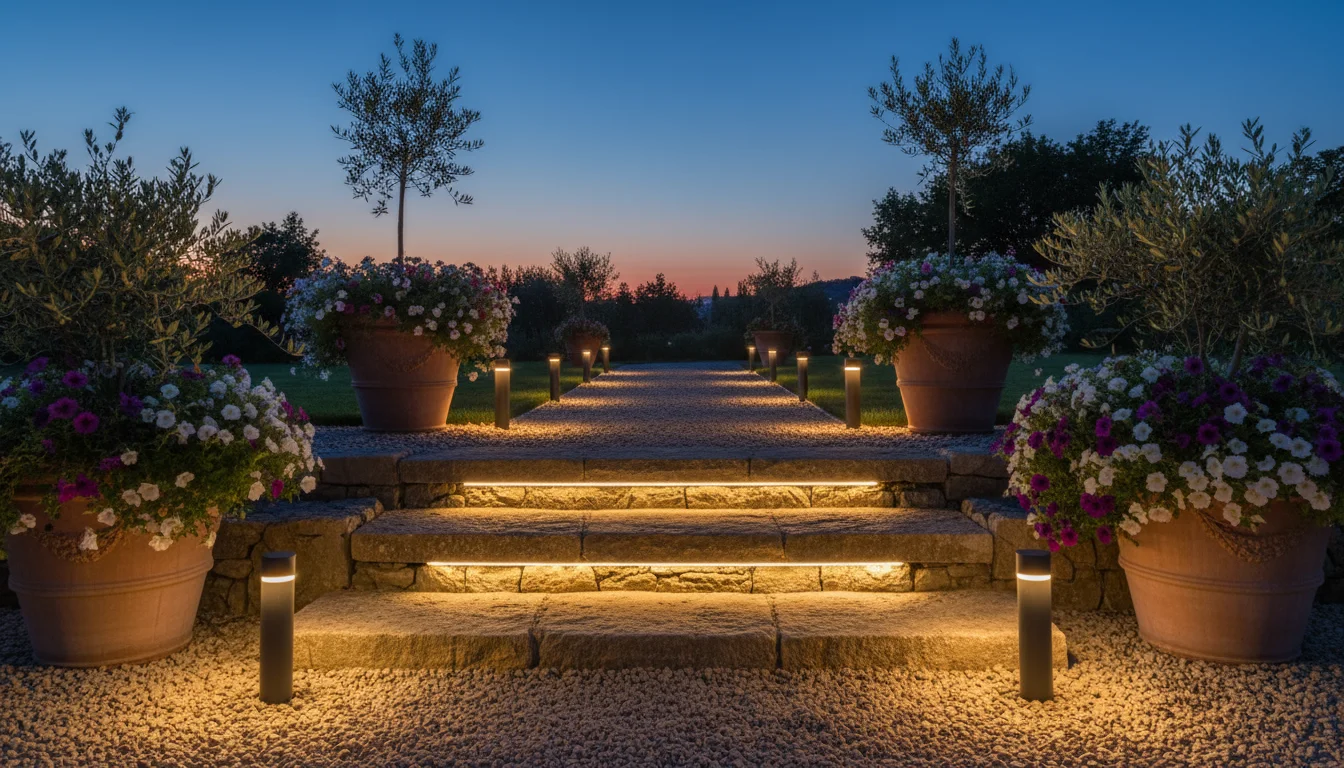
Safety First: Illuminating Pathways and Steps
In a small garden, where space is at a premium, obstacles can appear quickly. Clearly illuminating pathways, steps, and any changes in elevation is paramount for safety. You can achieve this with low-level path lights that cast a soft glow along the ground, clearly marking the route without causing glare. Position path lights approximately 4-6 feet apart, focusing light downwards to avoid shining directly into someone’s eyes. For steps, integrated step lights or small, well-placed puck lights at the edge of each riser provide sufficient illumination to prevent trips. Ensure any wiring for low-voltage systems is buried safely, typically at least 6 inches deep, to prevent damage and minimize tripping hazards.
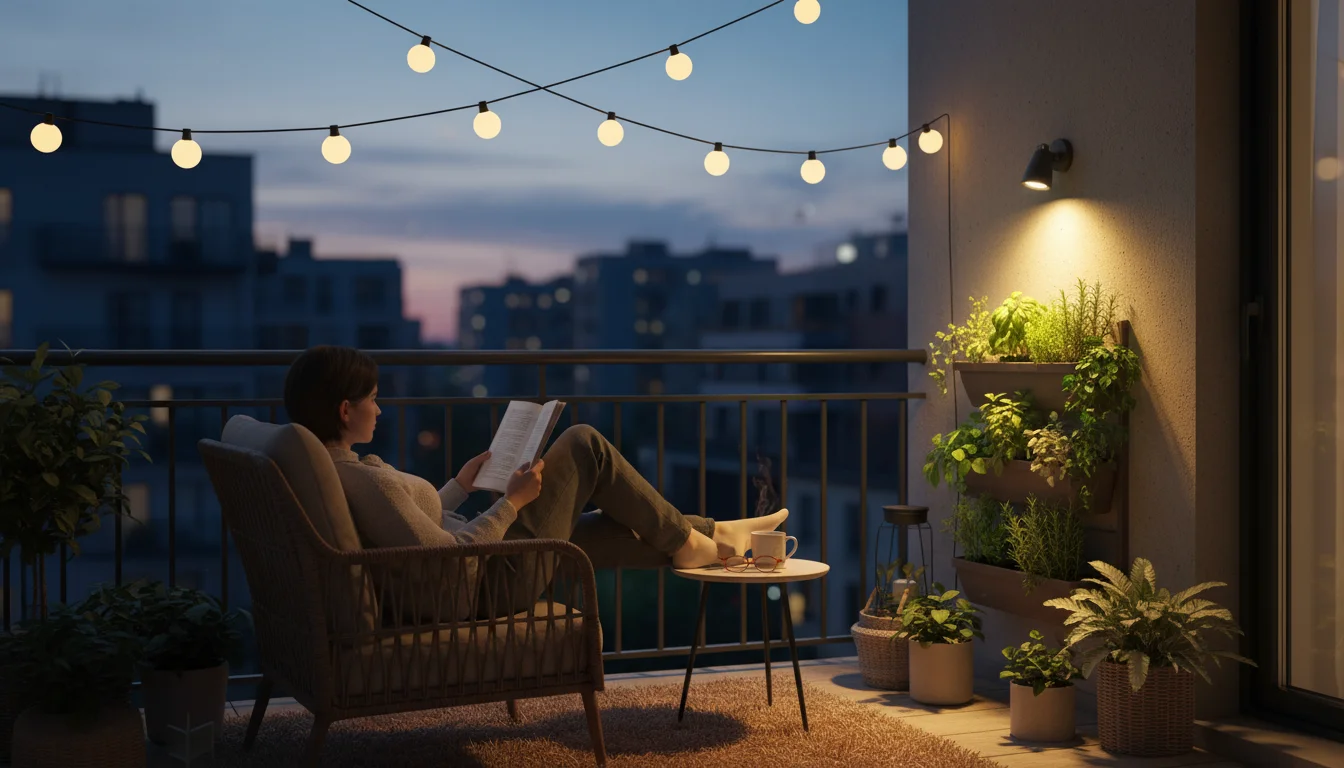
Controlling Glare for Comfort
Glare, or harsh, uncomfortable light, ruins the ambiance and can be disorienting. You must avoid directing bright lights towards seating areas or where people will look directly. Angle spotlights away from direct lines of sight, or use fixtures with diffusers to soften the light. Shielded fixtures, which direct light downwards, are excellent for path lighting as they illuminate the ground without blinding passersby. For string lights, choose bulbs with a lower lumen output or frosted finishes to provide a warm glow rather than an intense beam. The goal is to illuminate the features of your garden, not the eyes of your guests.
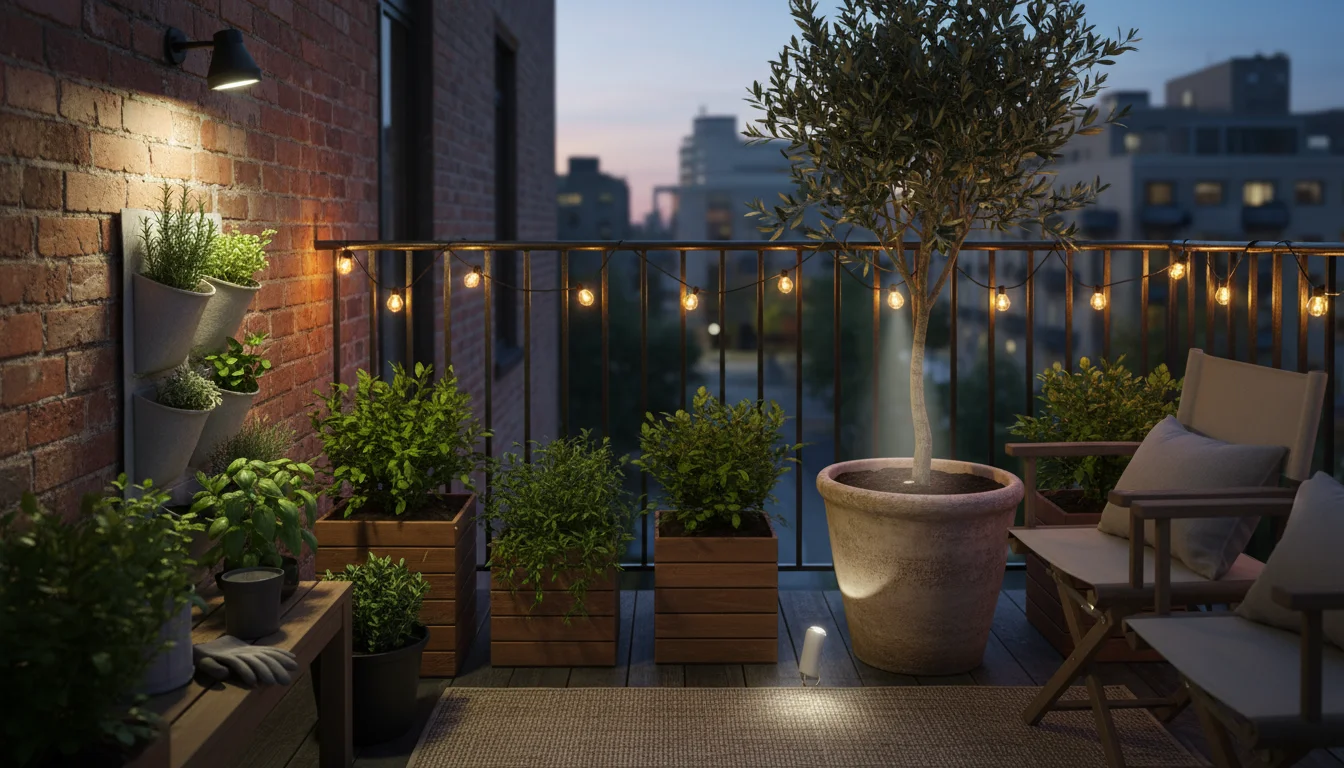
Smart Mounting Solutions for Small Spaces
Small gardens often lack extensive ground space for traditional stake lights. Get creative with your mounting options:
- Railings: You can attach string lights or small lanterns to balcony or patio railings using zip ties, hooks, or even small clamps. This elevates the light source, spreading illumination more effectively.
- Walls: Utilize wall space for sconces, uplights, or downlights. These fixtures can illuminate plants below or wash a wall with ambient light, creating depth without taking up floor space. Battery-operated picture lights can highlight wall-mounted planters.
- Planters and Containers: Integrate small, solar-powered spotlights directly into large planters to highlight the plants within. You can also hide miniature string lights within foliage to create a magical, glowing effect from the inside out. Some planters even come with integrated lighting.
- Pergolas and Overhangs: These structures are ideal for hanging string lights or pendant fixtures, creating a ceiling of light that defines the outdoor room.
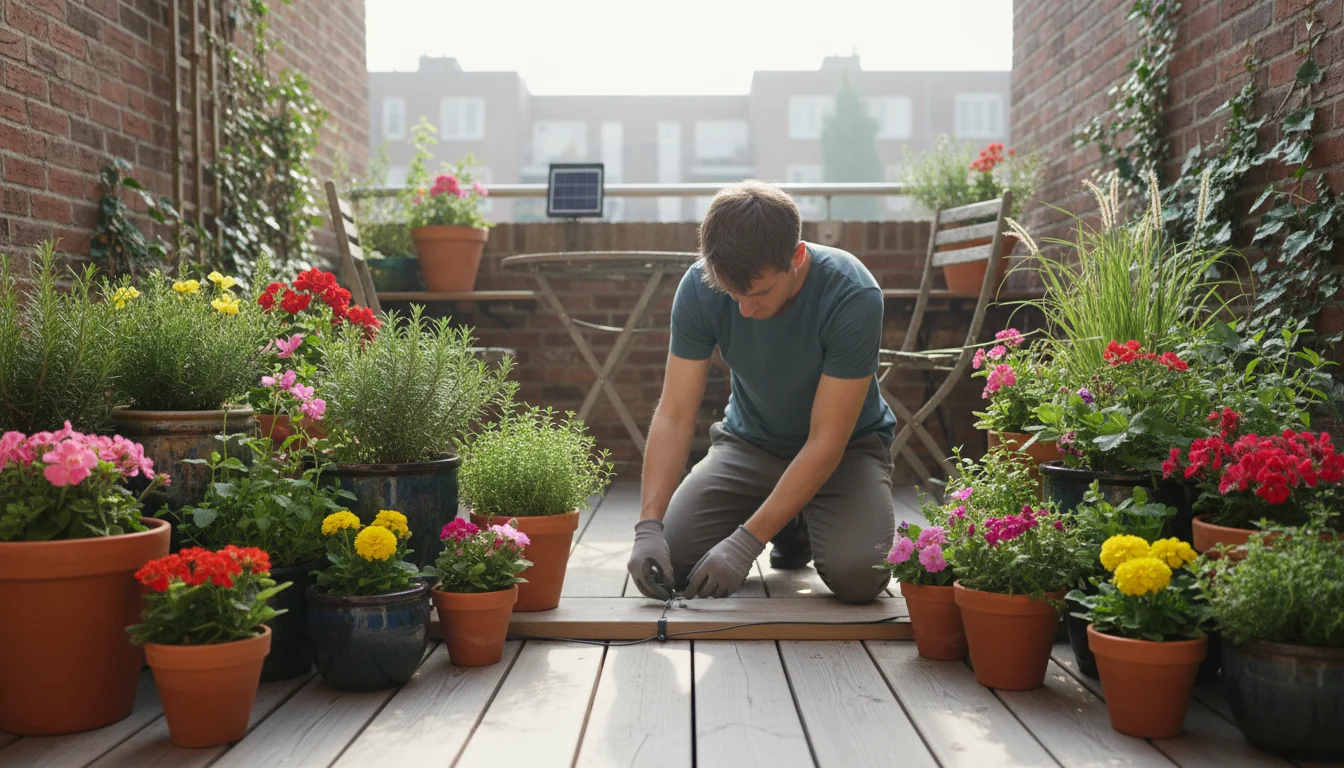
Managing Power Sources and Wires
Before installing any garden lighting, consider your power sources. Solar lights are the easiest, requiring no outlets or wiring, but their performance depends on sun exposure. Battery-operated lights offer flexibility but require regular charging or battery replacement. Low-voltage wired systems provide consistent power but need an outdoor, GFCI-protected outlet and careful wire management. You can discreetly hide wires by tucking them under deck boards, running them along fences, or burying them. For temporary setups, consider attractive cable covers or strategically place large containers to conceal wires. A well-managed power system ensures both safety and a clean aesthetic for your patio garden design.
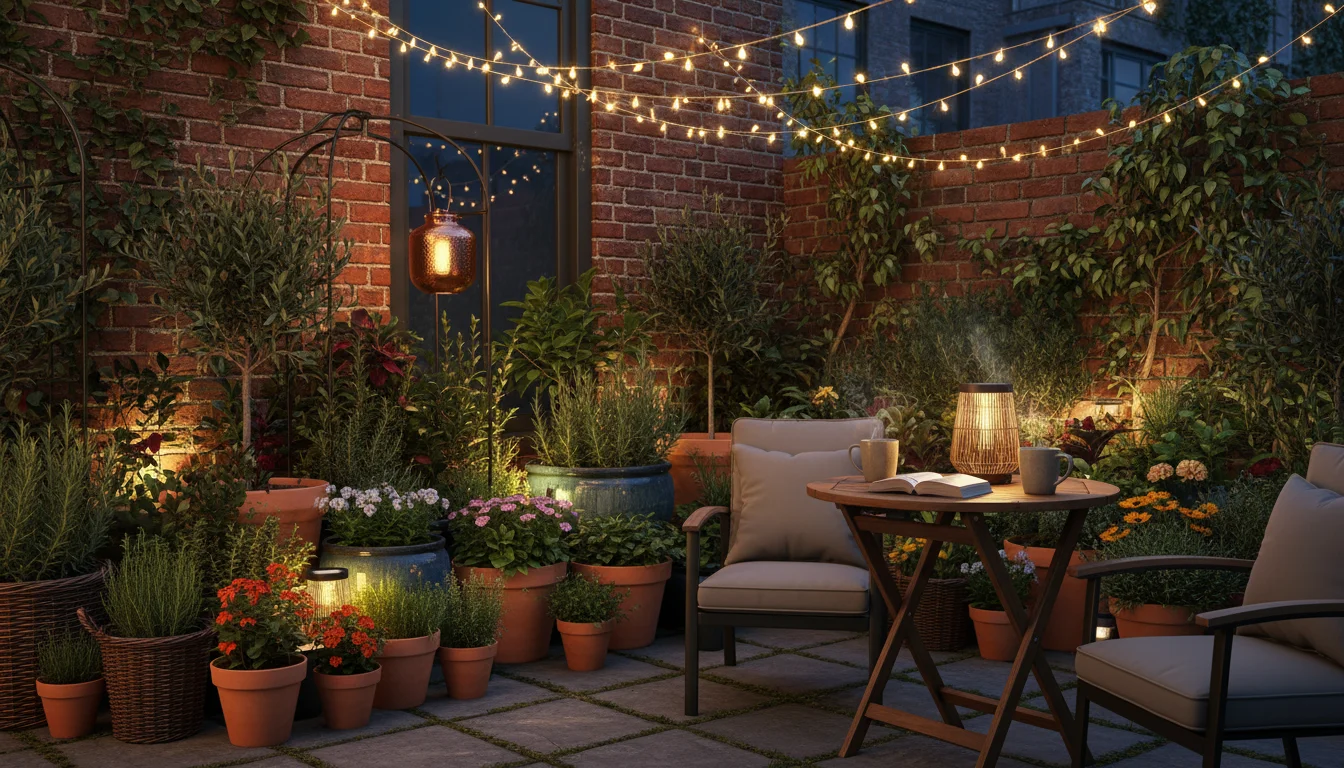
Sustainable Lighting Choices for Your Balcony or Patio
As a practical and environmentally conscious gardener, you want your garden lighting to be beautiful, functional, and gentle on the planet. Making sustainable choices for your balcony lighting or patio garden design helps conserve energy, reduces waste, and supports a healthier environment. Fortunately, many excellent options exist that align with these values.
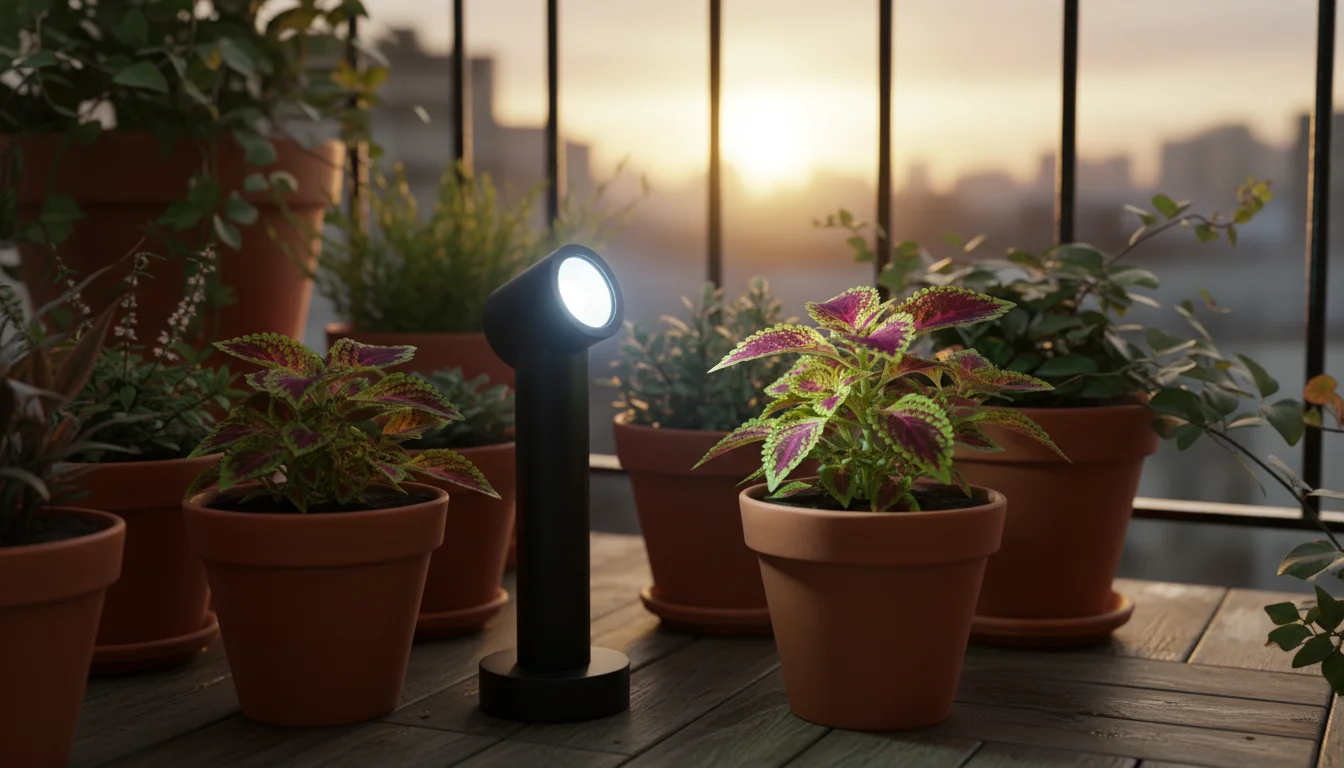
Embrace LED Technology
Light Emitting Diode, or LED, technology stands as the cornerstone of energy-efficient lighting. LED bulbs consume significantly less electricity than traditional incandescent bulbs, often using 75-80% less energy for the same light output. This translates directly into lower energy bills for you. Beyond energy savings, LEDs boast an incredibly long lifespan, often lasting 25,000 to 50,000 hours, compared to 1,000-2,000 hours for incandescents. This reduces the frequency of bulb replacement, cutting down on waste and maintenance time. When you choose garden lighting fixtures, prioritize those with integrated LEDs or ones that accept standard LED bulbs. The initial cost might be slightly higher, but the long-term savings and environmental benefits are substantial.
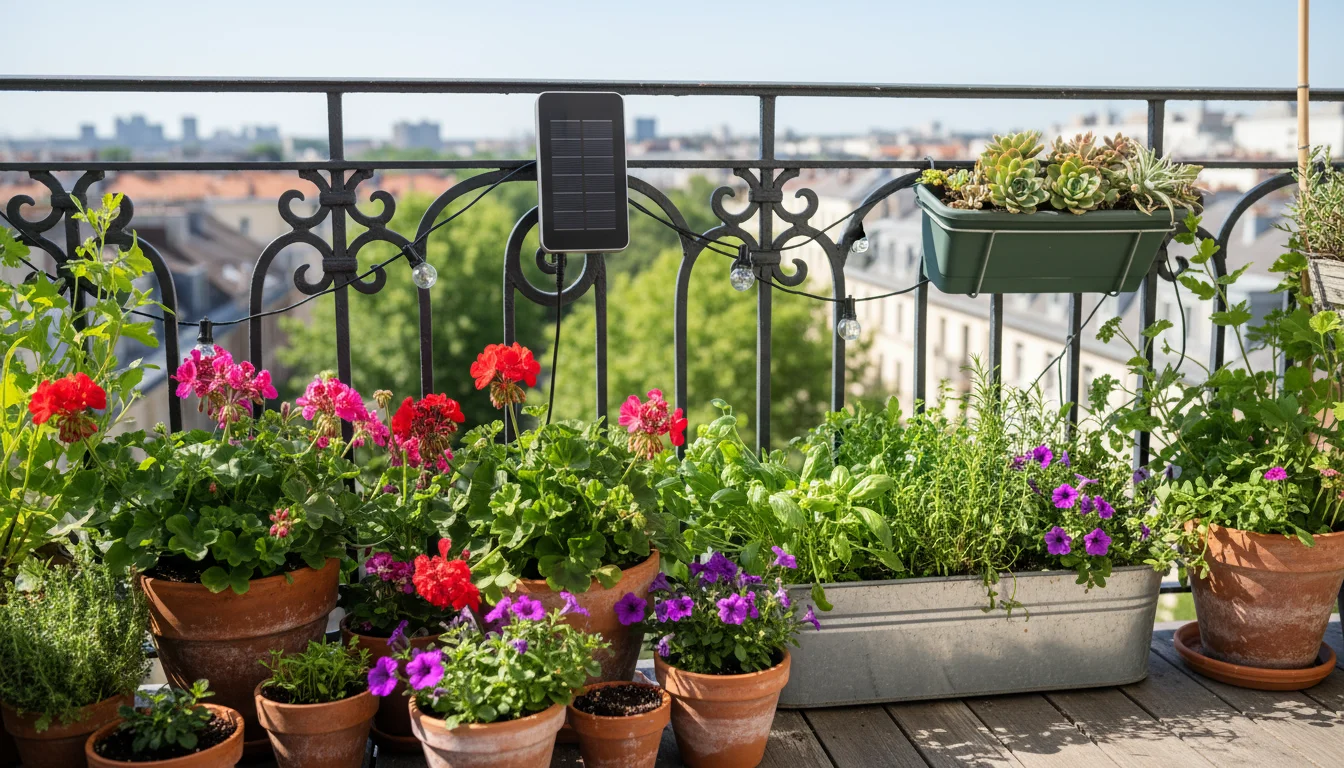
Harness the Sun with Solar Power
Solar garden lights offer the ultimate in energy independence. They operate entirely on renewable energy, charging their internal batteries during the day and illuminating at night. You pay nothing for electricity to run them. This makes them an excellent choice for balcony lighting where electrical outlets might be scarce, or for any patio garden design where you want to minimize wiring. When selecting solar lights, invest in reputable brands that use efficient solar panels and durable rechargeable batteries. Higher quality units typically offer brighter light and longer illumination times, even after partially cloudy days. While the brightness can sometimes be less intense than wired options, advancements in solar technology continue to improve performance, making them increasingly viable for accent and ambient lighting.
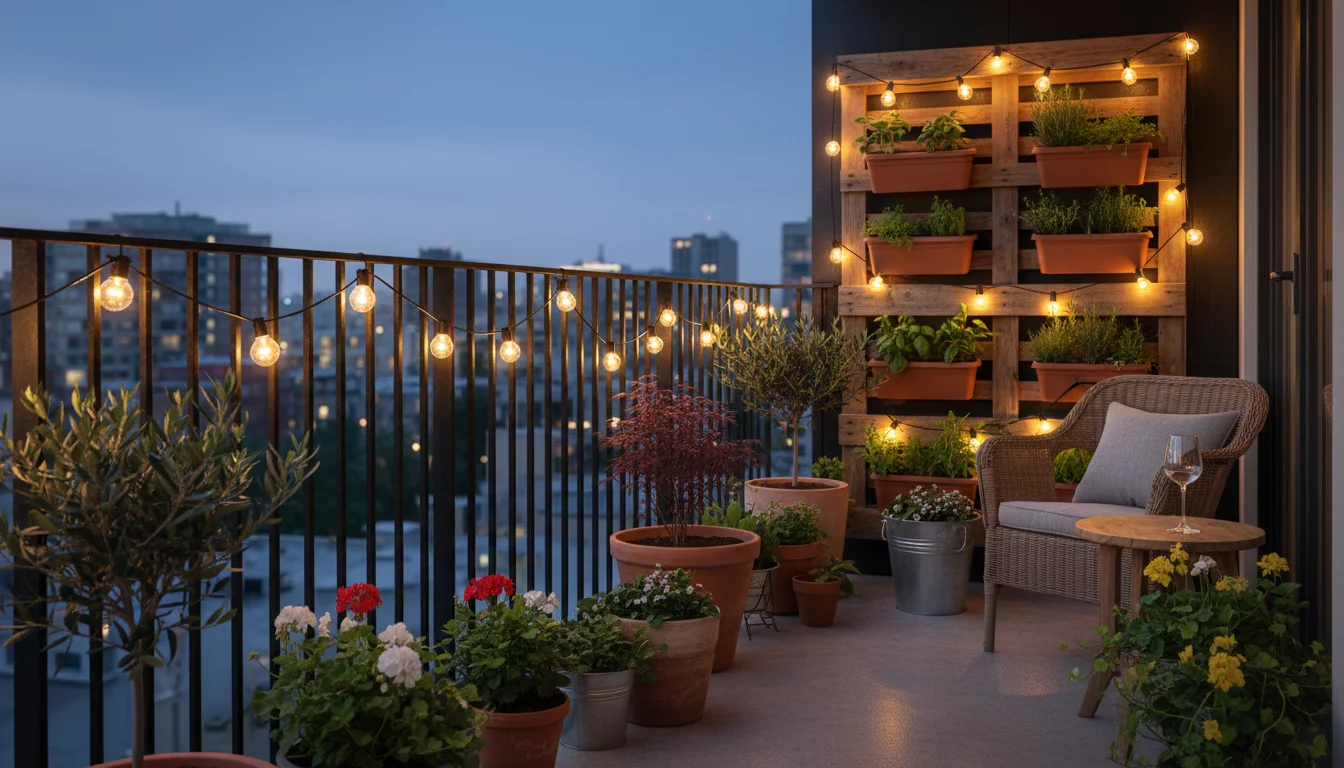
Automate with Timers and Sensors
Even the most energy-efficient lights waste power if you leave them on longer than necessary. Timers and photo-sensors provide a simple, yet highly effective, solution. Timers allow you to set specific on and off times for your lights, ensuring they only operate when you need them. For example, you can program your patio garden lights to come on at sunset and turn off a few hours later, preventing them from running all night unnecessarily. Photo-sensors, or dusk-to-dawn sensors, automatically turn lights on when it gets dark and off when the sun rises. These tools prevent energy waste due to forgetfulness and ensure your garden is illuminated only when it truly enhances your evening experience. Many modern string lights and low-voltage transformers come with built-in timers or sensor capabilities, making them easy to integrate into your sustainable lighting plan.
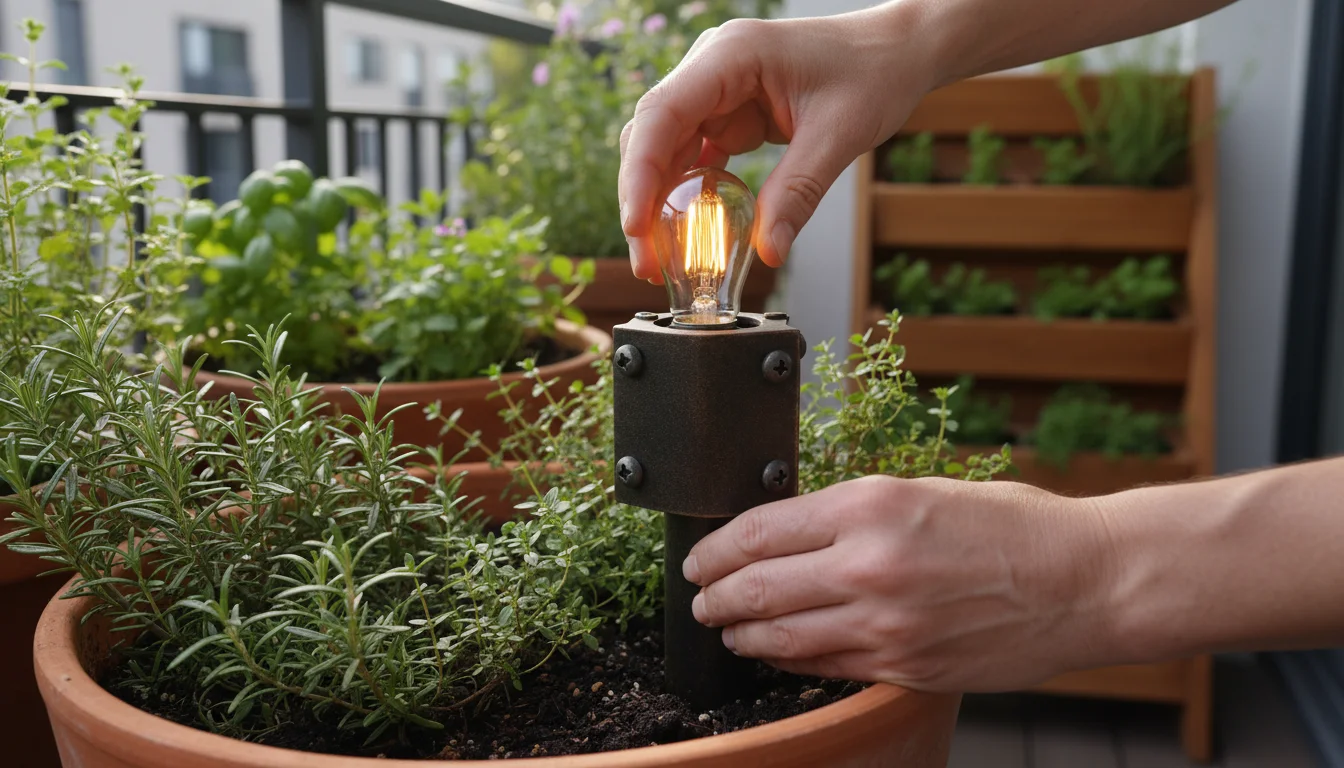
Choose Durable, Repairable Fixtures
Durability directly impacts sustainability. Investing in well-made, weather-resistant fixtures means they will last longer, reducing the need for frequent replacements and minimizing waste. Look for materials like marine-grade aluminum, brass, or high-quality plastics that resist rust and corrosion. You also want to consider whether a fixture is repairable. Can you replace a bulb, or is it a fully sealed, disposable unit? Opt for products that allow for component replacement when possible. This thoughtful selection extends the lifespan of your garden lighting and reduces your overall environmental footprint.
For more insights into sustainable gardening practices, including responsible resource use, consider exploring resources from the University of New Hampshire Cooperative Extension or other local university extension programs. They offer region-specific advice on everything from water-wise plants to eco-friendly landscaping.
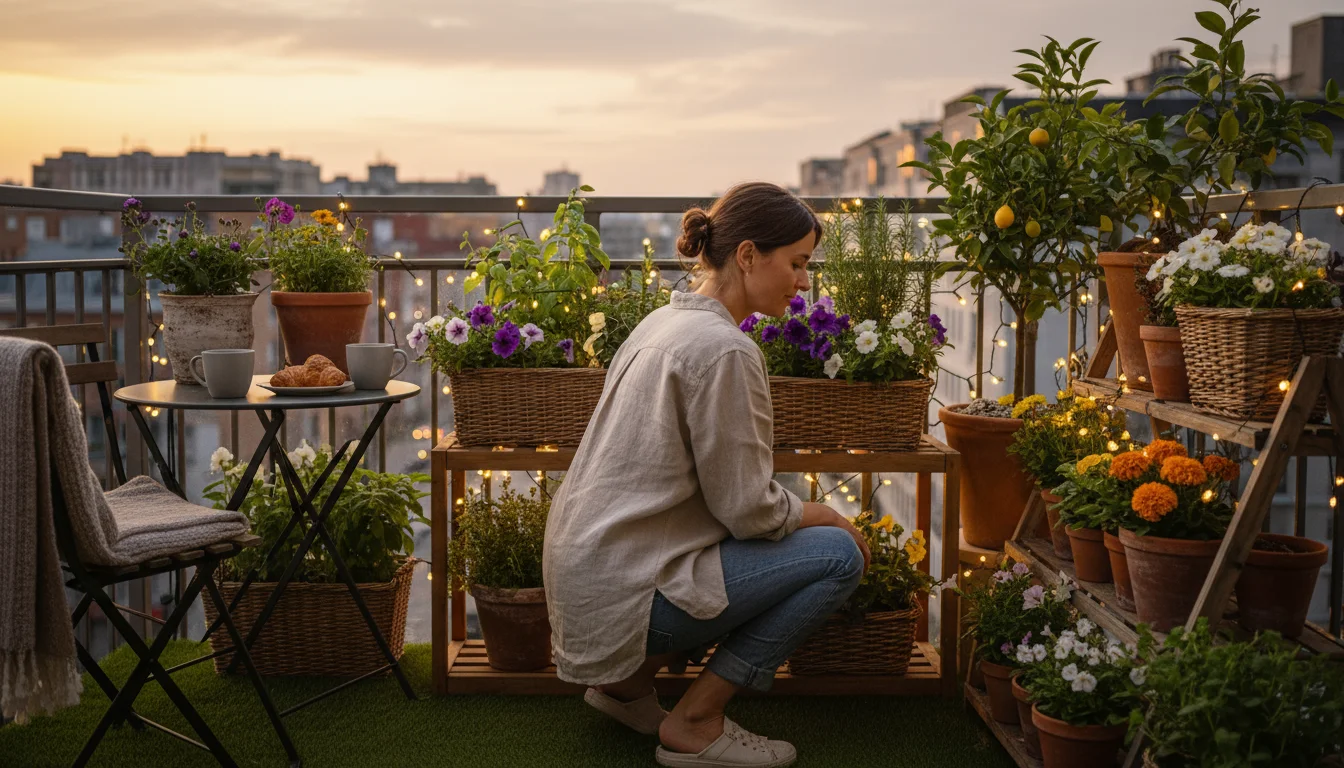
DIY Lighting Projects to Enhance Your Outdoor Oasis
You do not need to be an electrical expert to create beautiful and effective garden lighting. Many DIY projects offer simple, cost-effective ways to illuminate your small space, adding character and warmth. These projects are often perfect for a weekend afternoon, bringing immediate enjoyment to your balcony or patio garden design.
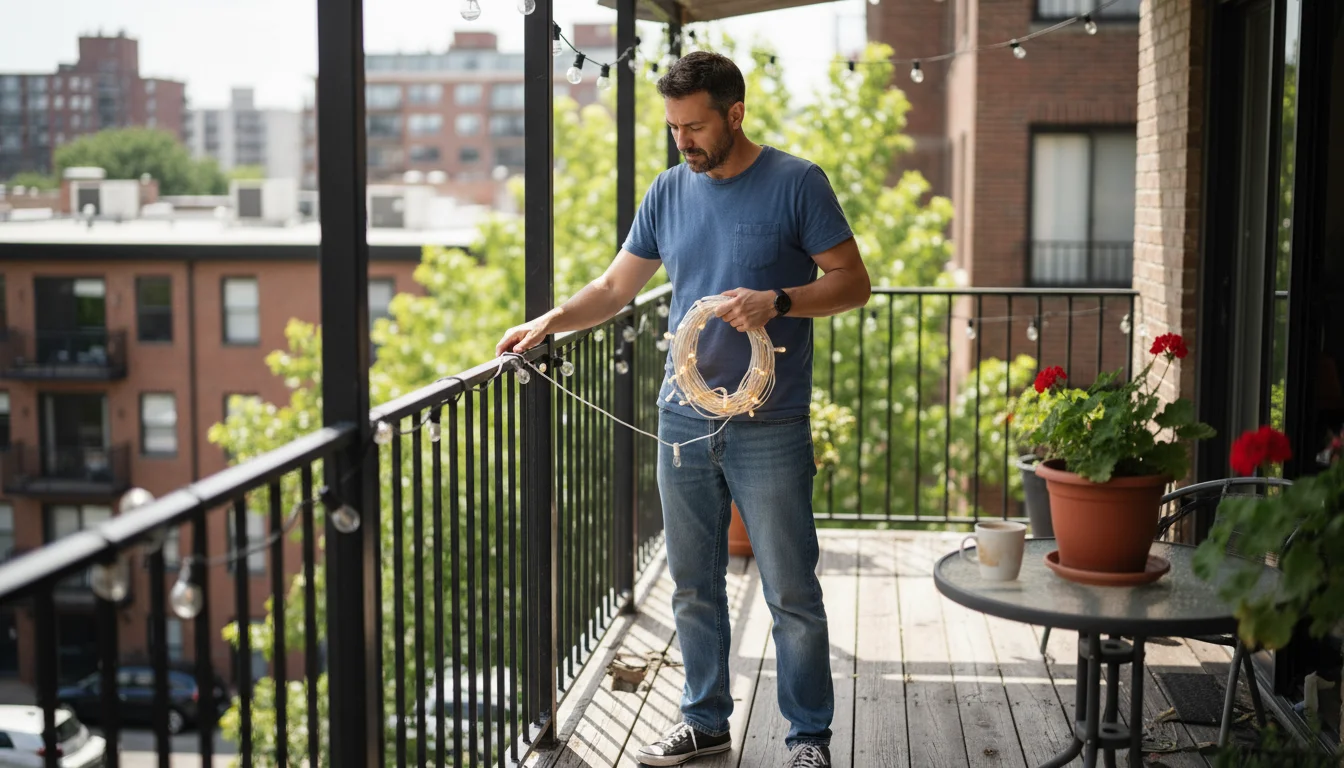
Installing String Lights for Instant Ambiance
String lights are perhaps the easiest and most impactful DIY lighting project for small spaces. Here is a simple step-by-step guide:
- Measure Your Space: Determine the length of string lights you need. Consider where you want to drape them: along a railing, crisscrossed overhead, or vertically on a wall.
- Choose Your Lights: Opt for outdoor-rated LED string lights. Solar-powered ones are excellent for balconies without easy outlet access. Look for a warm white color temperature for a cozy feel.
- Plan Your Path: Sketch out where the lights will go. If you are going overhead, identify attachment points like a wall, fence, or sturdy plant stand.
- Secure Attachment Points: Use outdoor-rated adhesive hooks, cup hooks screwed into wood, or zip ties for railings. For overhead installations, consider using a tension wire to support the string lights and prevent sagging, especially for longer runs.
- Hang Your Lights: Start from your power source (outlet or solar panel) and work your way out. Gently secure the lights at regular intervals, ensuring they hang evenly.
- Test and Adjust: Plug them in or wait for dusk. Make any necessary adjustments to spacing or tension.
This simple project instantly elevates your balcony lighting, making it inviting for evening use.
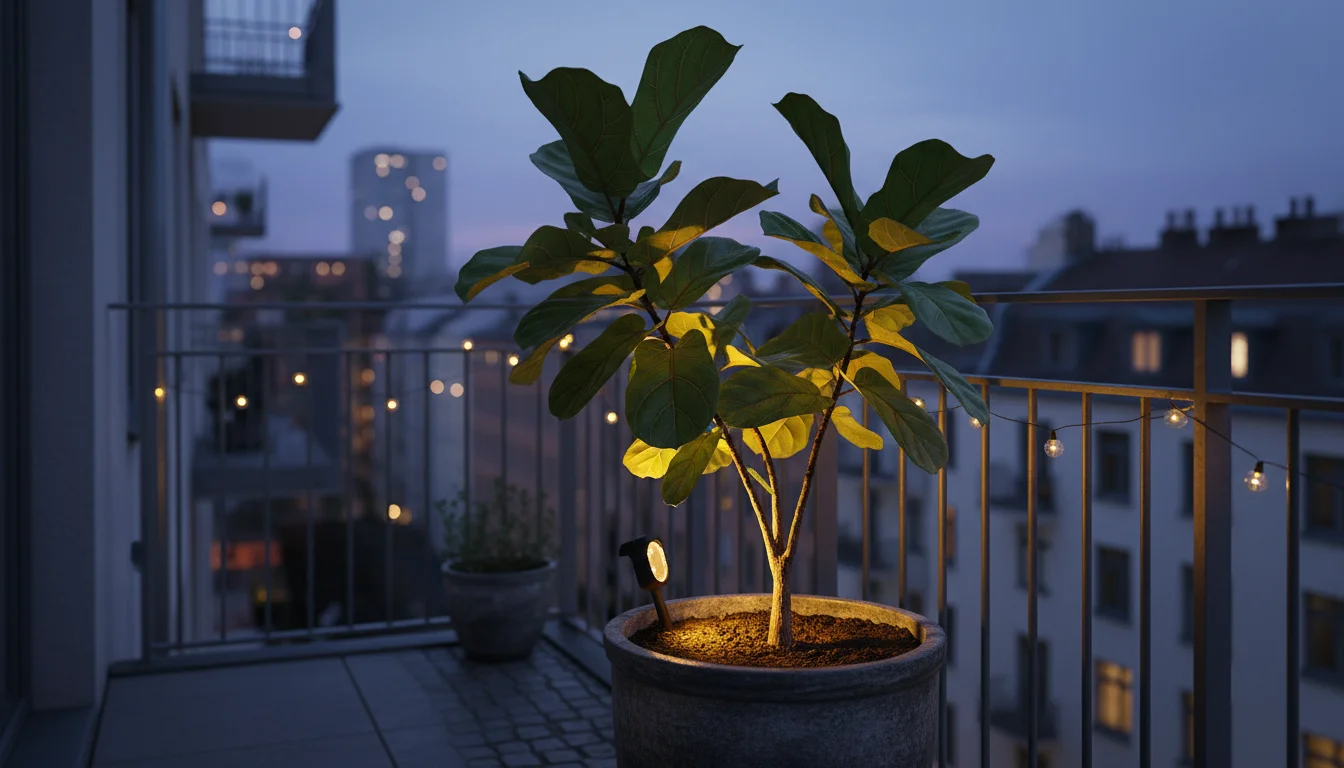
Creating Glowing Planters with Solar Spotlights
You can transform ordinary potted plants into glowing features with mini solar spotlights. This project works wonderfully for showcasing your favorite specimens or adding depth to your patio garden design:
- Select Your Plants: Choose larger potted plants or groupings that you want to highlight. Plants with interesting foliage, textures, or a unique silhouette work best.
- Pick Your Spotlights: Purchase small, outdoor-rated solar spotlights. Look for ones with adjustable heads so you can direct the light precisely.
- Placement in the Pot: Insert the stake of the solar spotlight into the soil at the base of your chosen plant. Angle the light so it shines upwards into the foliage or towards a specific feature of the plant.
- Optimize Sun Exposure: Ensure the small solar panel on the light receives direct sunlight for several hours during the day. You might need to adjust its position slightly to maximize charging.
- Observe and Adjust: At night, check the effect. Adjust the angle of the light head until you achieve the desired dramatic or subtle illumination.
This trick adds sophistication without requiring any wiring or complex installation.
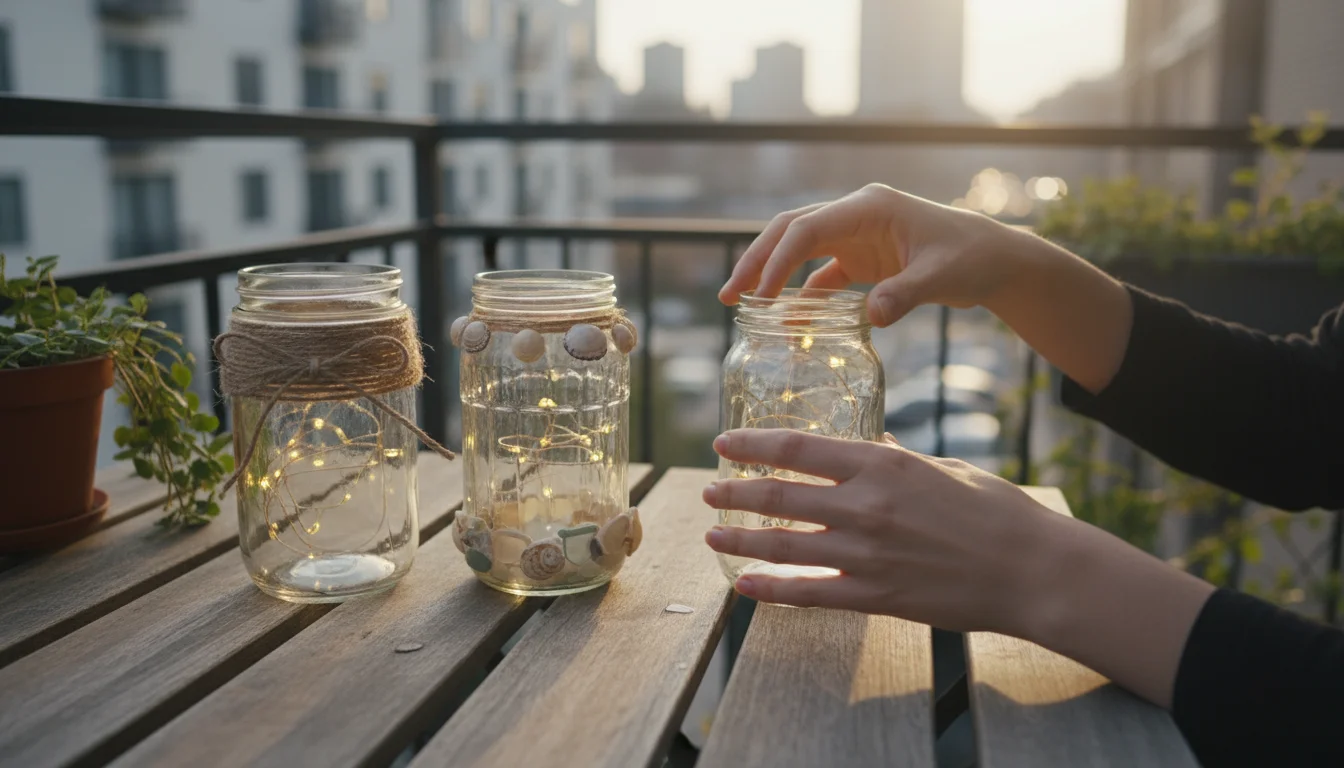
Upcycled Jar Lanterns with Fairy Lights
For a whimsical touch, repurpose glass jars into charming, battery-operated lanterns:
- Gather Materials: You need clean glass jars (mason jars, old pickle jars), battery-operated LED fairy lights (the tiny ones on a thin wire), and optional decorative elements like twine, ribbon, or pebbles.
- Insert Fairy Lights: Carefully unspool the fairy lights and place the battery pack inside the jar, often hidden at the bottom. Then, gently arrange the light strand throughout the jar.
- Decorate (Optional): Add a layer of decorative pebbles or small shells at the bottom to stabilize the battery pack and add visual interest. Tie twine around the rim for a rustic look, or add a handle for hanging.
- Place or Hang: Set your glowing jars on tables, ledges, or hang them from hooks or branches using sturdy twine or wire.
These customizable lanterns provide a soft, enchanting glow and allow you to add your personal touch to your garden lighting scheme.
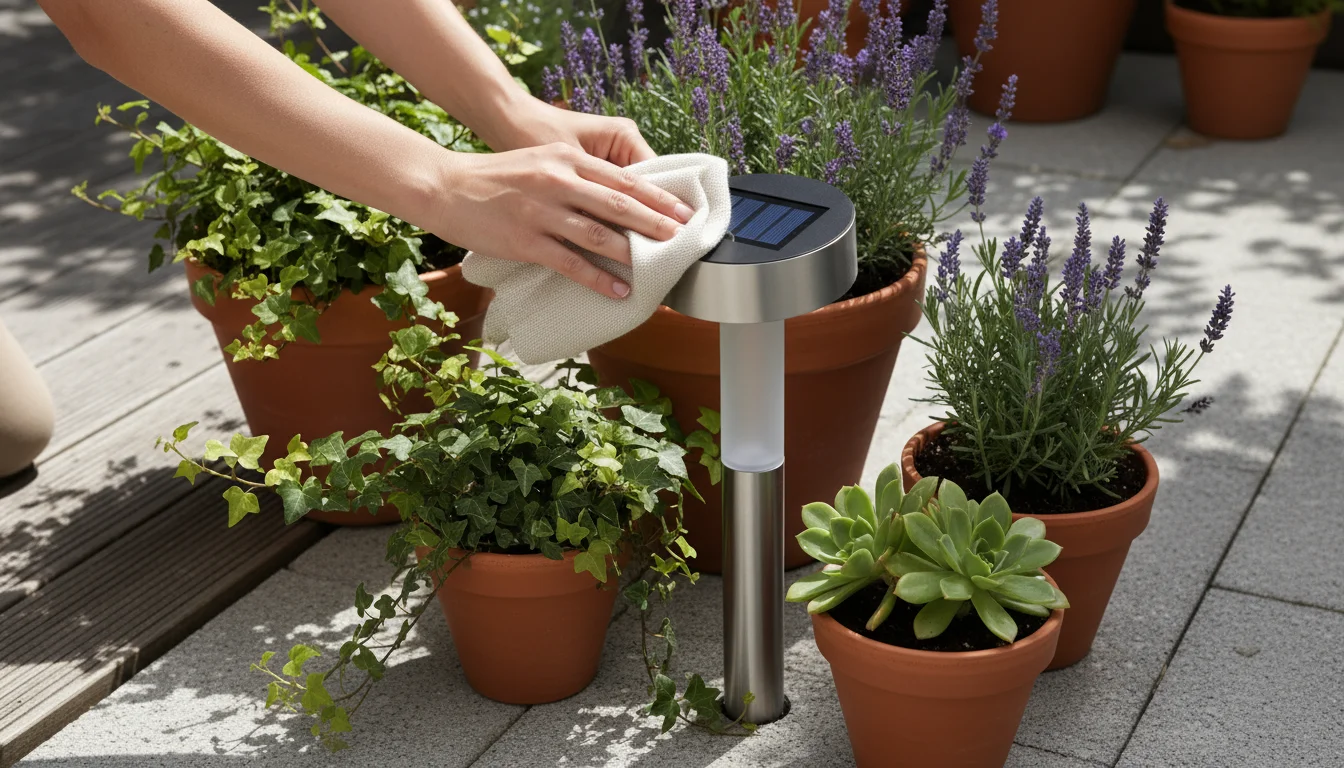
Maintenance Tips for Lasting Garden Lighting
Even with low-maintenance choices, a little attention goes a long way in ensuring your garden lighting performs beautifully season after season. Regular, simple tasks keep your lights shining brightly and extend their lifespan, maximizing your investment in your small space. Consistent maintenance helps you avoid unexpected outages and maintains the aesthetic appeal of your balcony lighting and patio garden design.
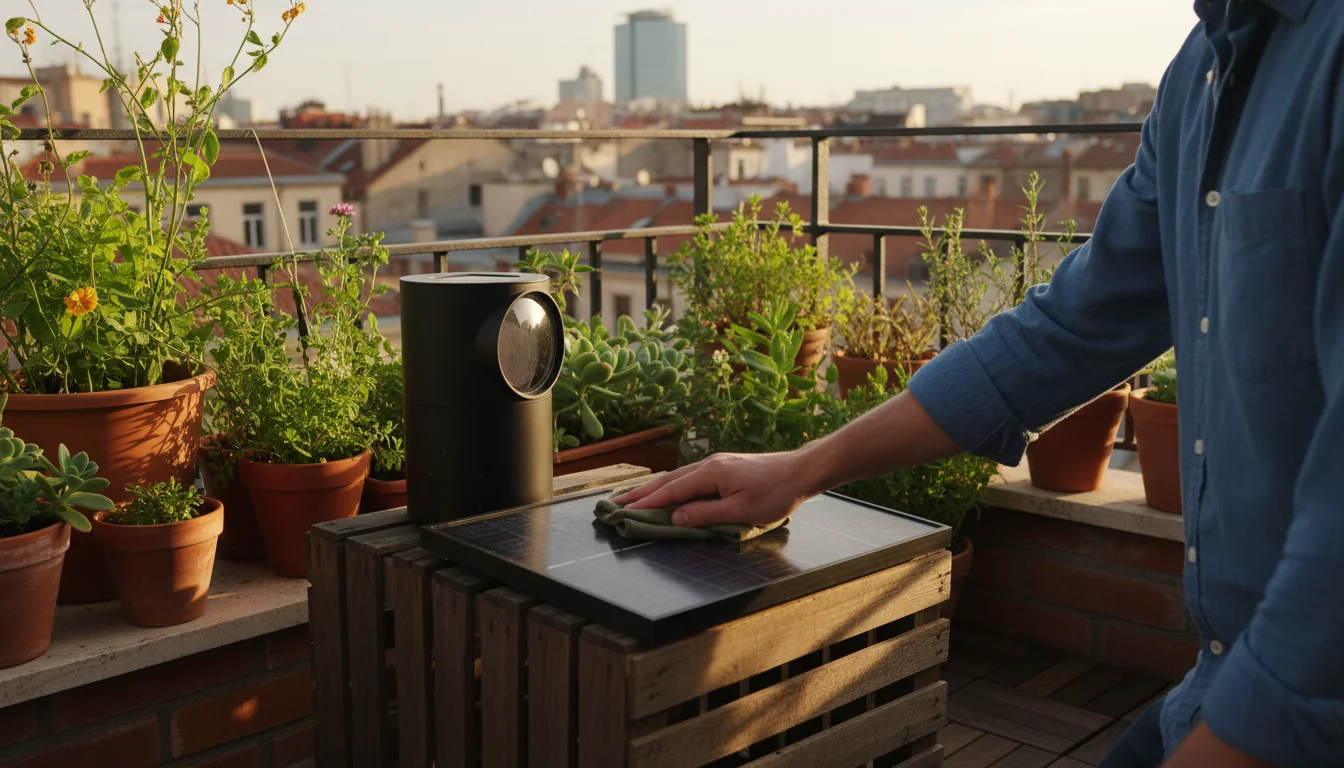
Regular Cleaning for Optimal Performance
Dirt, dust, pollen, and even bird droppings can accumulate on light fixtures, particularly on solar panels and light lenses. This accumulation directly impacts performance. A dirty solar panel cannot efficiently absorb sunlight, leading to dim lights or shorter illumination times. Similarly, a grimy lens diffuses or blocks light, reducing brightness. Make it a habit to wipe down solar panels and light lenses every few weeks with a soft, damp cloth. For more stubborn grime, use a mild soap solution. Ensure you clean the fixtures when they are cool and unplugged if they are wired. This simple act significantly boosts efficiency and light output.
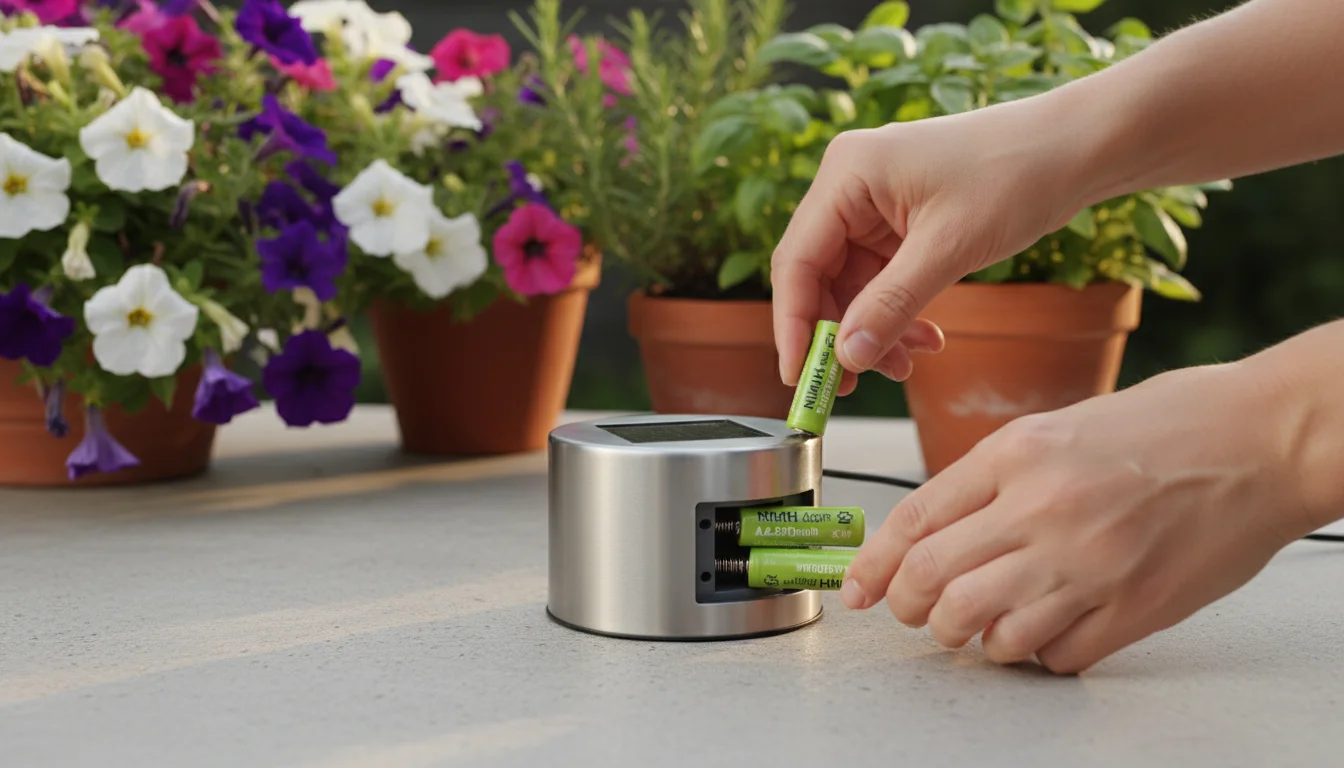
Battery Replacement and Charging Routines
Battery-operated and solar lights rely on rechargeable batteries, which have a finite lifespan. Typically, these batteries last 1-3 years before their capacity diminishes. If you notice your solar lights becoming dimmer or staying lit for shorter periods, it is likely time to replace their internal rechargeable batteries (usually AA or AAA NiMH). For non-solar battery-operated lights, simply replace the disposable batteries as needed or establish a regular charging schedule for rechargeable units. Always use the recommended battery type for your fixtures to ensure optimal performance and safety.
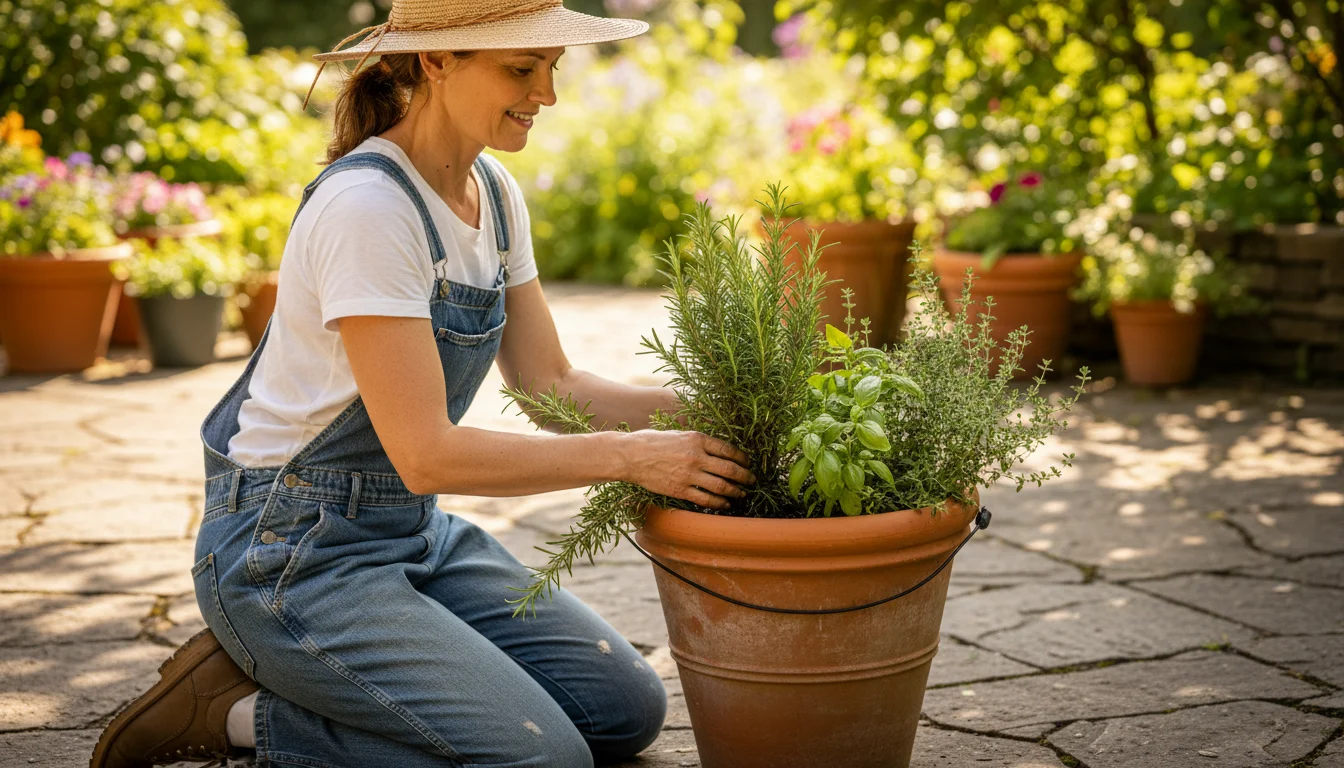
Inspecting Wiring and Connections
For low-voltage wired garden lighting systems, periodic inspection of wires and connections is essential. Over time, wires can become exposed, damaged by garden tools, or gnawed by pests. You should visually check all exposed wiring for cuts, fraying, or degradation. Ensure all connections are secure and free of corrosion. If you spot any damage, repair it promptly or consult a qualified electrician. While you might not need to do this every month, an annual check, perhaps during spring garden cleanup, helps prevent electrical issues and maintains system integrity. You can find guidelines on safe electrical practices from organizations like the National Fire Protection Association.
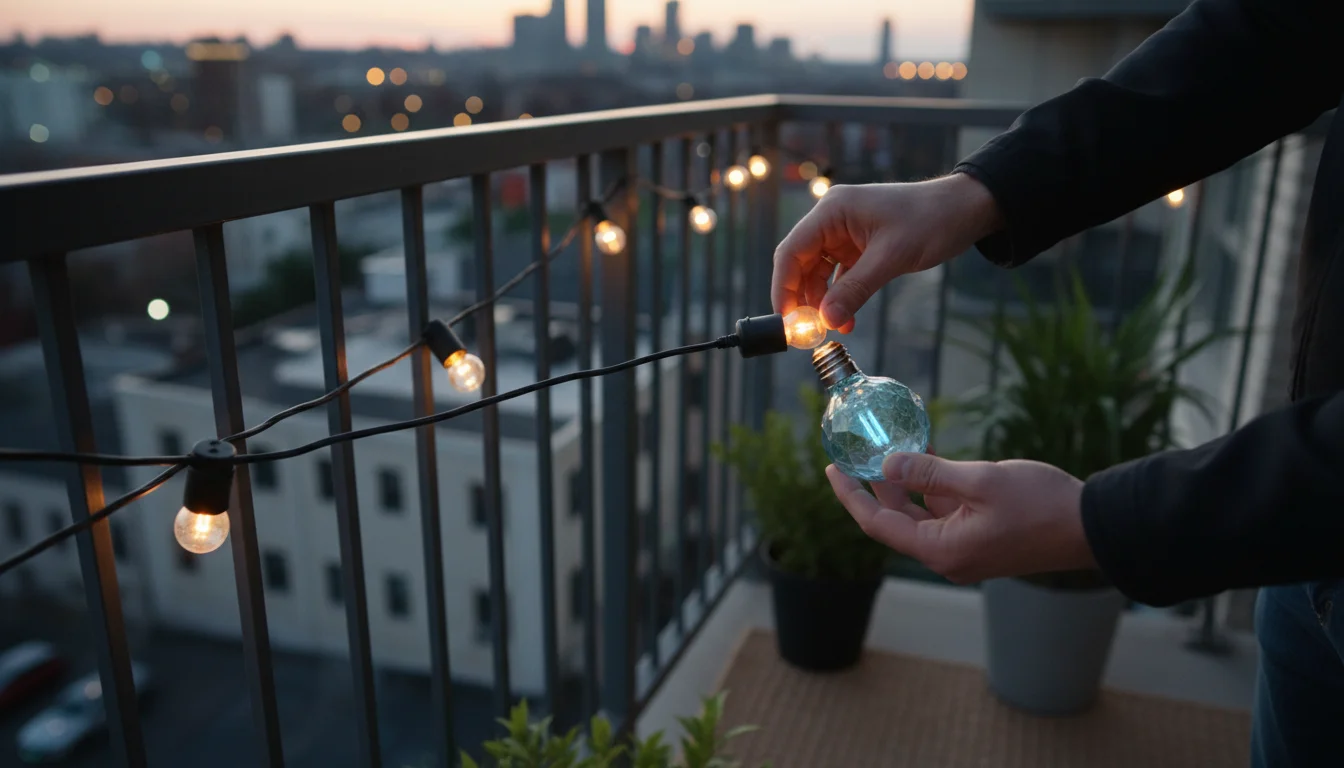
Bulb Checks and Replacements
Even long-lasting LED bulbs eventually fail. If a string light bulb goes out, replace it promptly to prevent strain on the rest of the circuit. For traditional fixtures, keep spare bulbs on hand. When replacing bulbs, ensure you use the correct wattage and type specified by the manufacturer. If you are using colored lenses or diffusers, check them for cracks or fading and replace if necessary to maintain consistent light quality.
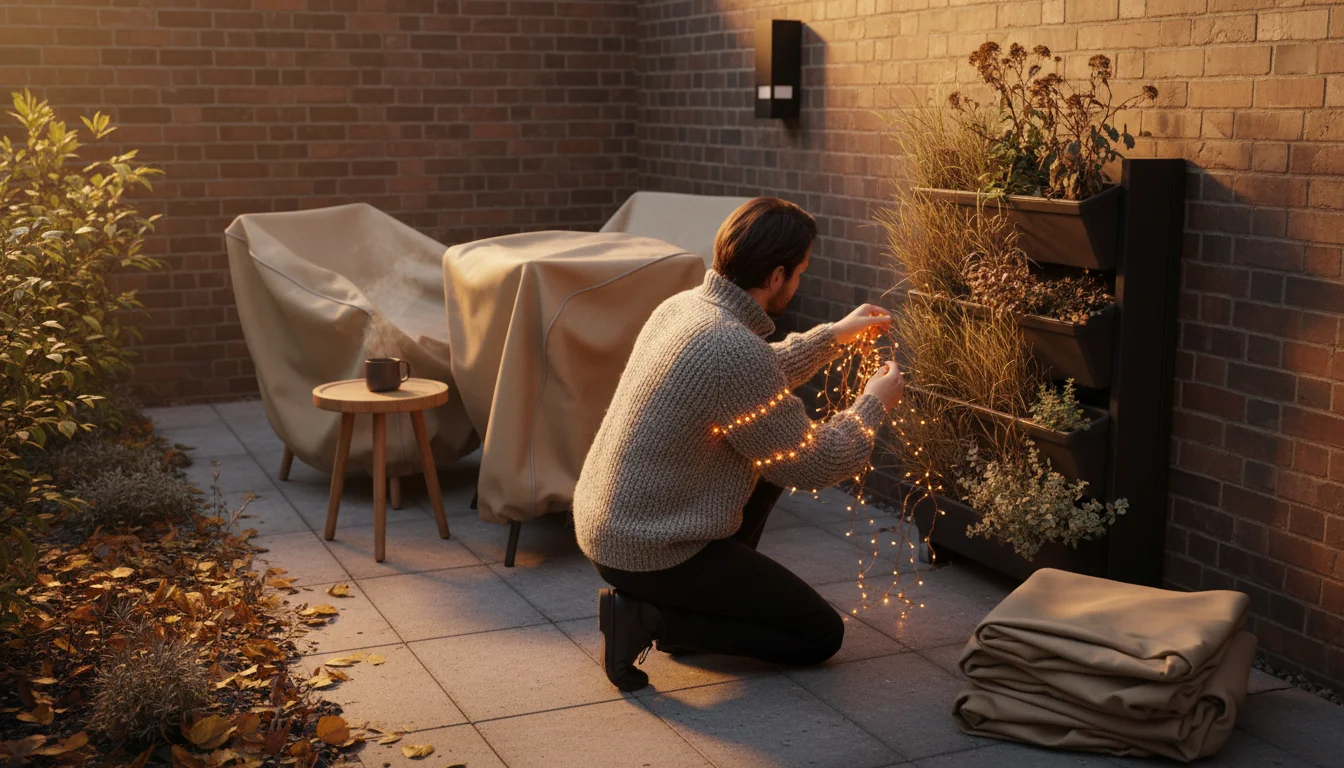
Winterizing and Weather Protection
While many outdoor lights are weather-resistant, extreme conditions like heavy snow, ice, or prolonged freezing temperatures can impact their longevity. For delicate string lights or less robust solar units, consider bringing them indoors for the winter. For permanent fixtures, ensure they are securely mounted and that any drainage holes are clear to prevent water accumulation. If you live in an area with harsh winters, you might want to invest in covers for your more expensive fixtures or ensure your low-voltage system is rated for severe weather conditions. Proper winterization prevents damage and costly replacements, keeping your garden lighting ready for spring.
For general gardening and plant care advice that complements your lighting design, including tips on choosing resilient plants, you can always consult reliable resources like your local Oregon State University Extension service or similar university extension programs in your region. They provide evidence-based guidance to help your entire small garden thrive.
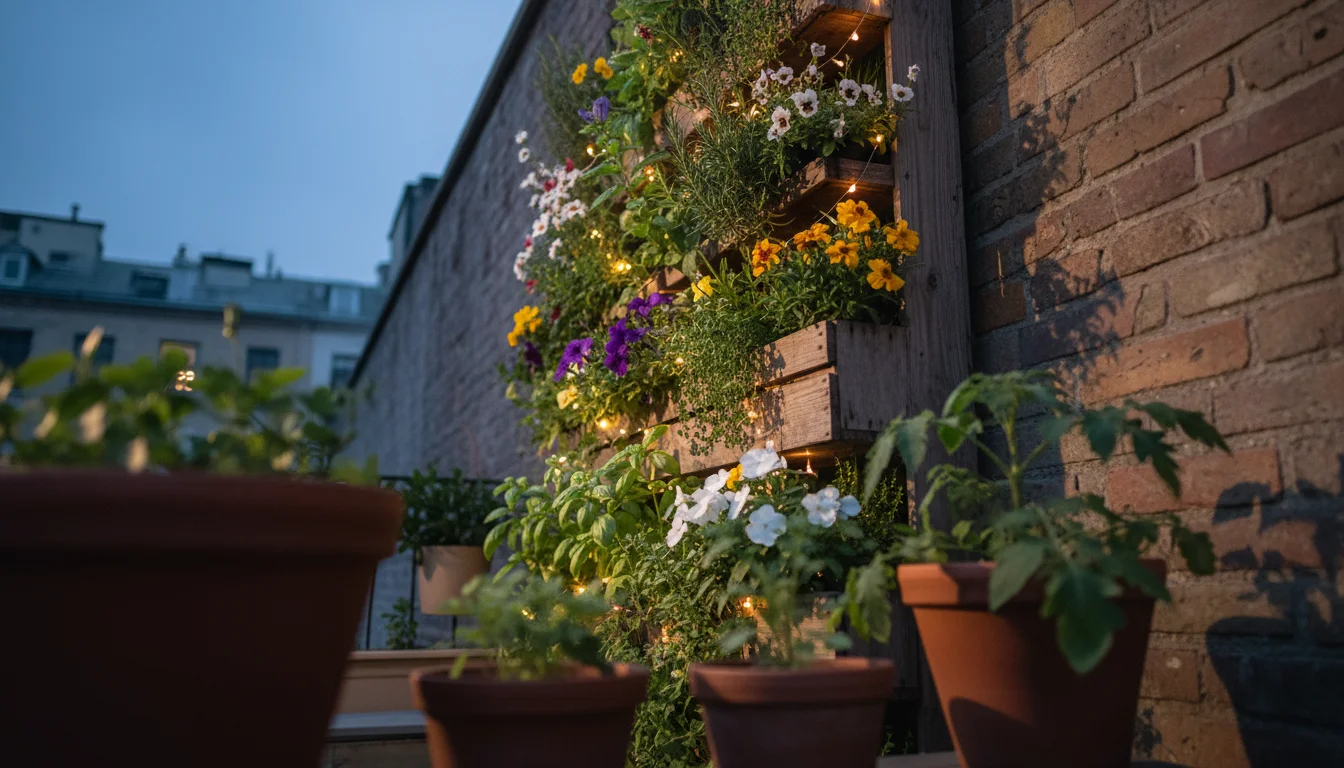
Frequently Asked Questions
How many lights do I need for a small balcony or patio?
The number of lights you need depends on the size of your space and your desired ambiance. For ambient lighting, a good rule of thumb for string lights is to aim for about 10-20 feet of lights per 50 square feet of area. For accent lighting, you might need 1-3 spotlights for a few key plants or features. Focus on layering light rather than just adding more lights. Often, fewer, strategically placed lights create a more impactful and sophisticated look than an abundance of randomly placed ones.
Can I mix solar and electric lights in my small garden?
Yes, absolutely. Mixing solar and electric lights is an excellent way to leverage the strengths of both systems. You might use solar path lights for areas where wiring is difficult or undesirable, and then complement them with electric string lights for overhead ambiance or wired spotlights for dramatic focal points. Ensure your electric lights are on a separate circuit or timer from your solar ones, as they operate independently. This approach offers flexibility and maximizes both convenience and lighting impact.
How do I hide unsightly wires in a compact outdoor space?
Hiding wires is crucial for a clean and polished patio garden design. For low-voltage wired systems, you can bury wires discreetly along the edges of planters, under gravel, or beneath deck boards. Use wire clips to secure them neatly along fences, walls, or railings, painting them to match the surface if possible. For temporary or flexible setups with string lights, consider running wires behind furniture, through the channels of railing posts, or using decorative planters to conceal their path to an outlet. You can also use outdoor cable covers that blend with your decor, or simply choose solar or battery-operated options to eliminate wires entirely in certain areas.
What’s the best color temperature for garden lighting?
Most experts recommend a warm white color temperature for garden lighting, typically ranging from 2200K to 3000K (Kelvin). This range produces a soft, inviting glow reminiscent of candlelight or incandescent bulbs, which enhances natural colors and creates a cozy, relaxing ambiance. Cooler temperatures (above 4000K) tend to appear harsh or sterile in a garden setting, more suitable for task lighting in a workshop than for creating a comfortable outdoor retreat. Always check the Kelvin rating on light packaging to ensure you select the appropriate warmth for your desired atmosphere.
For design and plant selection guidance, visit
Chicago Botanic Garden,
Brooklyn Botanic Garden, and
New York Botanical Garden.
Disclaimer: This article is for informational purposes only and is not a substitute for professional advice. Consult local extension services for region-specific recommendations, especially concerning electrical work.
